Iceland Self-Drive Travel Guide: Traffic Rules, Road Conditions, Parking, Refueling, and Important Considerations
Iceland has attracted an increasing number of travelers in recent years, becoming a popular emerging tourist destination. Iceland’s attractions are mainly natural landscapes, but due to its vast area and scattered attractions, coupled with the inconvenience of public transportation outside the capital, self-driving or joining tour groups (Local Tour) are the two main options for traveling in Iceland. In July of this year (2018), I went on a self-drive trip in Iceland, and here I’ve organized the information and experiences from this trip to share with everyone, including traffic rules, road conditions, highway facilities, parking, refueling, GPS navigation, and other important considerations for driving in Iceland.
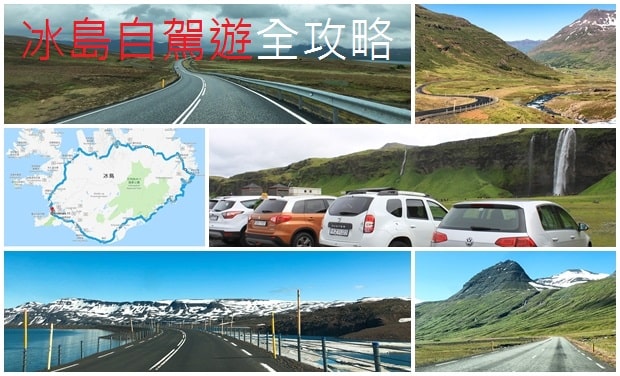
Many people think of Iceland as a place covered in ice and snow. While this is true in winter, during summer, except for glaciers and the central highlands, most areas are snow-free, and many places are lush and green. Therefore, summer is absolutely suitable for self-driving in Iceland. However, even in summer, temperatures remain relatively cold, and with frequent rain and strong winds, the perceived temperature usually does not exceed 10°C, so winter clothing is still necessary for a summer trip to Iceland.
Summer in Iceland generally lasts from June to August, and these three months are the most ideal for a self-drive trip, as well as the peak tourist season. If you are only driving in southern Iceland, from the capital Reykjavík to Vík, May and September are generally also suitable. I am naturally cautious and dislike seeking thrills. Although I enjoy self-driving, safety is my top priority, so I have never driven in icy and snowy conditions and do not recommend self-driving in Iceland outside of summer, especially between October and April. This article shares experiences and information about self-driving in Iceland during summer, but if you plan to drive in Iceland during winter, most of the content in this article is still applicable for reference.
Complete Guide to Self-Driving in Iceland
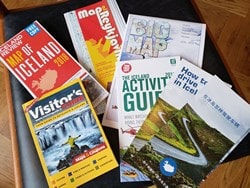
The following are the three main Icelandic organizations that provide safety information for foreign tourists:
In reality, self-driving in Iceland during summer is not difficult. As long as you don’t speed and drive carefully, accidents are generally unlikely. In fact, it can be safer than driving in other places. In busy areas with heavy traffic, even if you are careful, accidents can occur due to the carelessness of other drivers. However, in Iceland, with fewer people and vehicles, the chance of collisions with other vehicles is lower. Most accidents are self-inflicted, so as long as you are careful, follow traffic rules, and don’t speed, accidents are unlikely. Of course, accidents caused by nature are another matter, but if you are not driving in winter and stay on official roads, such accidents are rare. With fewer vehicles on the road, even beginners will find driving in Iceland less stressful than in places like Japan, where traffic is heavy, making it relatively more relaxed.
This article focuses on introducing information and experiences related to self-driving in Iceland. For another important aspect of self-driving in Iceland—car rental—please refer to another article. Due to its length, this article is divided into the following ten sections:
- 1. Requirements for Self-Driving in Iceland
- 2. Key Traffic Rules to Know for Self-Driving in Iceland
- 3. Classification and Road Conditions of Icelandic Roads
- 4. Main Roads and Road Conditions for Self-Driving in Iceland
- 5. Rest Stops, Toilets, and Considerations When Stopping to Take Photos on Icelandic Roads
- 6. Special Considerations When Driving on Icelandic Roads
- 7. Tolls on Icelandic Roads
- 8. Parking and Fees in Iceland
- 9. Refueling
- 10. Navigation
1. Requirements for Self-Driving in Iceland
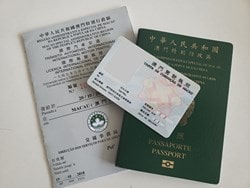

Anyone holding a valid driver’s license issued by their home country can drive vehicles of the same class in Iceland, except for commercial vehicles. If your home country’s driver’s license uses Latin script (e.g., English, Portuguese, German, French, Italian, etc.), you can use it directly. However, if your license does not use Latin script (e.g., Chinese, Japanese, Korean), you will need additional documentation to prove you have a valid license. The simplest and most commonly used option is an International Driving Permit (International Driving License). If you cannot obtain an International Driving Permit, you can use an English translation of your home country’s driver’s license certified by an approved notary. The International Driving Permit or English translation must be used together with your home country’s driver’s license to be legally valid. However, car rental companies generally do not require you to present your home country’s license, though the police may ask for it, so it’s best to carry both.
2. Key Traffic Rules to Know for Self-Driving in Iceland
Basically, traffic rules around the world are not very different: stop at red lights, go at green lights, yield to pedestrians at crosswalks, no drinking and driving, etc. These are basic rules that don’t need special explanation. Below, we’ll only highlight some unique traffic rules in Iceland that require extra attention.
1. Driving Direction
In Iceland, traffic drives on the right side of the road, and vehicles are left-hand drive, similar to Taiwan, Mainland China, South Korea, the U.S., and continental European countries, but opposite to Japan, Malaysia, Singapore, and Hong Kong.
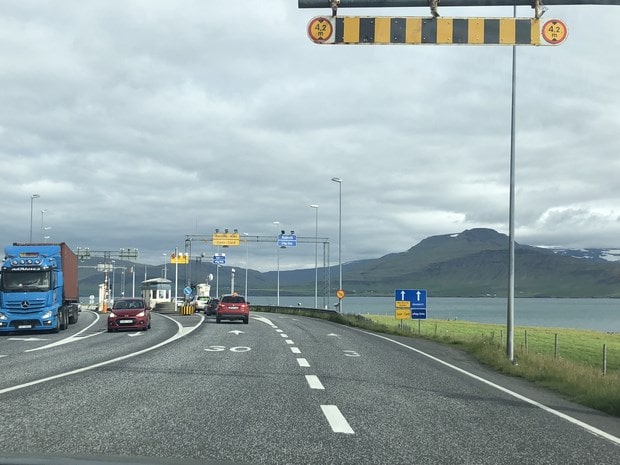

The issue of driving on the wrong side mainly occurs when turning at intersections. However, as long as you pay attention, you’ll quickly get used to it, and passengers can also remind you, so it’s not a big problem. A harder adjustment is judging the space outside the car, which may take longer to get used to.
Outside Reykjavík, most roads in Iceland are two-lane, two-way roads, with no barriers or railings separating the lanes. Most roads are not very wide, and there are no guardrails on the sides, only roadside posts. If you drive too close to the edge, you might hit a post or even veer off the road, so be extra careful when passing oncoming traffic. Due to the sparse population, you’ll often encounter no oncoming traffic for long stretches, allowing you to drive closer to the centerline. When oncoming traffic appears, move to the right and slow down. If you’re not used to left-hand drive, try to reduce your speed to a manageable level when encountering oncoming traffic.
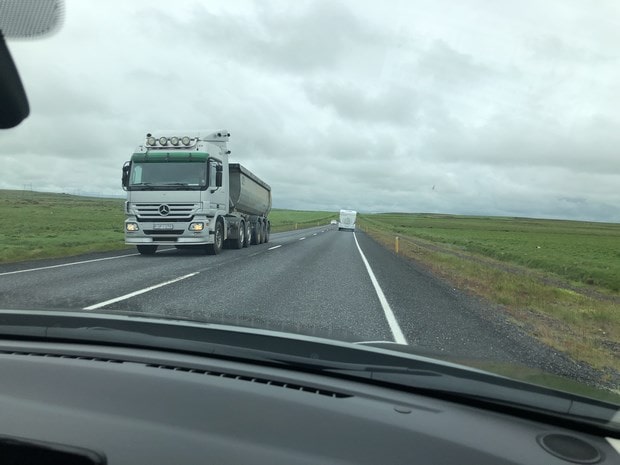

When I encountered oncoming traffic during my self-drive trip in Iceland, I would slow down. If the oncoming vehicle was a car, reducing speed to around 70 km/h was usually sufficient to feel in control. However, if it was a large vehicle, I would slow down to below 40 km/h or even stop and wait for it to pass. Of course, if you’re from Taiwan or Mainland China and are used to driving right-hand drive vehicles, this might not be an issue, and you may not need to slow down for oncoming traffic. However, it’s still advisable to slow down when encountering oncoming traffic, as high speeds from both directions can kick up gravel from the roadside, potentially damaging your car or windshield.
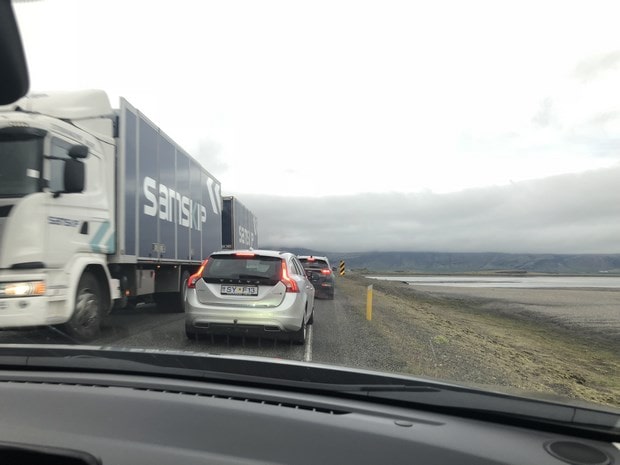

2. Overtaking
Most roads in Iceland are two-lane, two-way roads, so overtaking is common. Since I’m not very accustomed to left-hand drive, I rarely overtook during my self-drive trip in Iceland—I was mostly the one being overtaken. When the centerline is a white dashed line, overtaking is allowed on that stretch. If it’s a solid white line, overtaking is prohibited. When overtaking, if conditions allow, leave some distance before returning to your lane. If you return too close to the vehicle behind, gravel kicked up from the road could affect them.
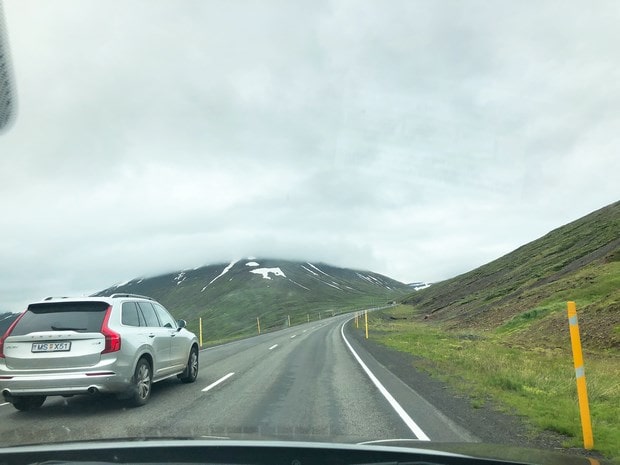

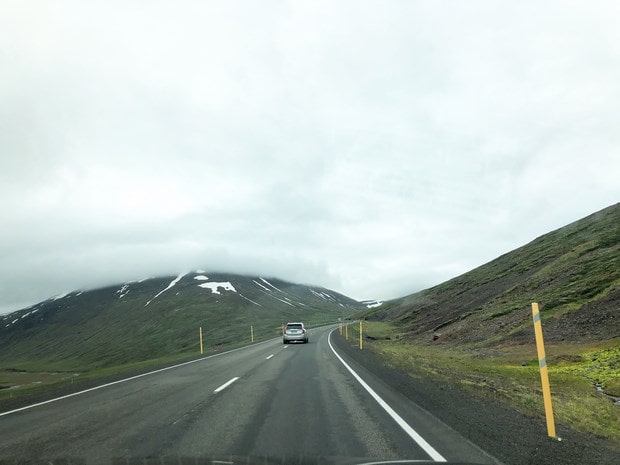

Additionally, overtaking is also prohibited in sections marked with the following traffic sign. If there are numbers below the sign, they indicate the prohibited overtaking section. For example, the sign below shows “0.2 – 1.7 km,” meaning overtaking is prohibited for the 1.5 km stretch between 0.2 km and 1.7 km ahead.
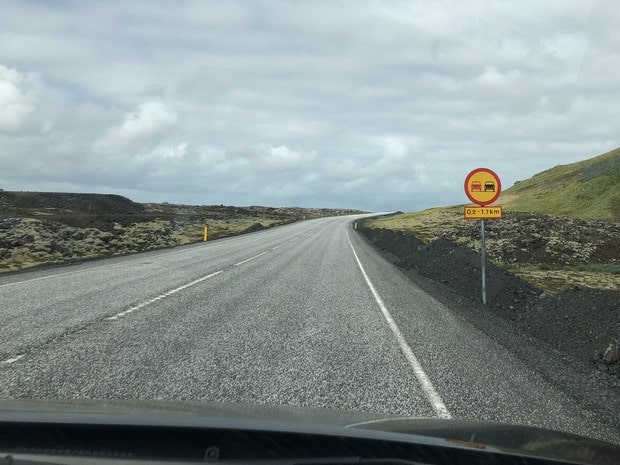

3. Headlights
One of Iceland’s most unique traffic rules is that vehicles must have their headlights on at all times while driving. In summer, Iceland has almost no darkness, and driving without headlights is not a problem, but the law requires them, so you must comply. Since we’re used to turning on headlights only at night, in tunnels, or in indoor parking lots, it’s easy to forget to turn them on while driving in Iceland. If caught driving without headlights, you can be fined 20,000 ISK.
Many newer vehicles automatically turn off the lights when the engine is shut off. If you’re driving such a vehicle, you can leave the headlight switch on, so you don’t have to worry about forgetting to turn them on. However, if your vehicle’s lighting system is separate from the engine and doesn’t turn off automatically, you’ll need to pay attention to the headlight switch—not only to ensure the lights are on when driving but also to make sure they’re off when the engine is off to avoid draining the battery.
Iceland’s laws require headlights to be on while driving but also prohibit the use of high beams (i.e., full beams) in urban areas. High beams can be used outside urban areas, but in summer, unless there’s heavy fog, there’s usually no need for them. If you’re using high beams and encounter oncoming traffic, switch to low beams to avoid blinding the other driver.
4. Speed Limits and Speed Monitoring
Speeding is the leading cause of traffic accidents in Iceland, so speed monitoring and penalties are strict. Fines for speeding range from 20,000 to 240,000 ISK, depending on how much you exceed the limit, the speed limit in effect, and the type of vehicle.
Iceland has a 5 km/h buffer for speeding. As long as you don’t exceed the speed limit by more than 5 km/h, you won’t be fined. For example, if the speed limit is 90 km/h, you won’t be fined unless you exceed 95 km/h. Similarly, if the limit is 50 km/h, you won’t be fined unless you exceed 55 km/h, and so on.
Speed limit signs are posted at regular intervals on Icelandic roads, making it easy to know the current limit. Outside urban areas, the speed limit is generally 90 km/h. On gravel roads, the limit drops to 80 or 70 km/h, and on sharp bends or sections with obstructed visibility, it’s reduced to 50 km/h. In tunnels, the limit is usually 70 km/h, and there may also be temporary speed limits due to roadwork or other special reasons. In urban areas, including Reykjavík and small towns with just a few dozen residents, the speed limit is generally 50 km/h, dropping to 30 km/h near pedestrian crossings in city centers.
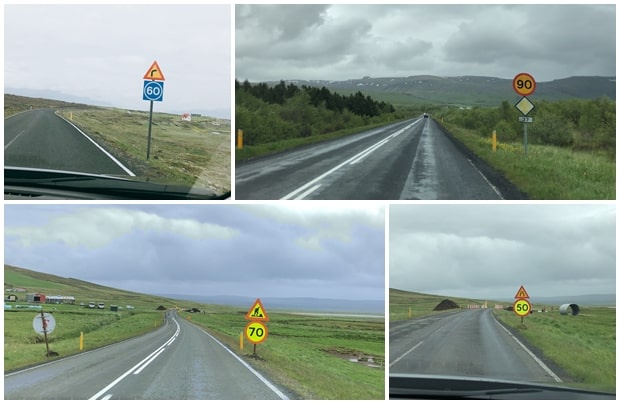

When approaching a town, the speed limit usually drops to 70 km/h first, followed by a short buffer section before further reducing to 50 km/h. So, when you see a 70 km/h speed limit sign near a town, slow down to below 50 km/h as soon as possible.
Before entering a town, you’ll see a yellow sign with a black building symbol, indicating that you’re entering an urban area, and the speed limit will gradually decrease from 90 km/h to 50 km/h.
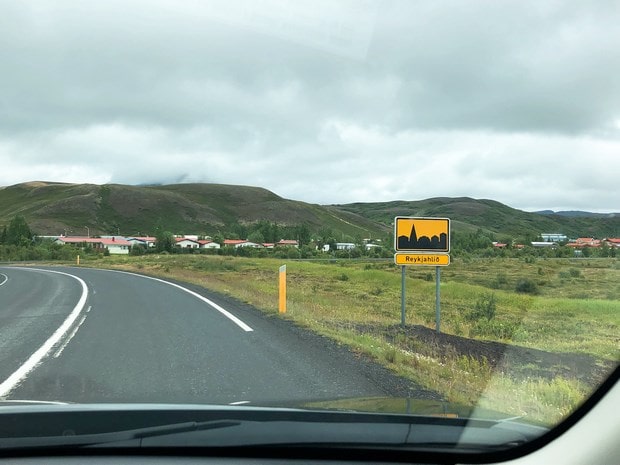

Some towns also have more prominent signs reminding drivers to slow down as they enter the urban area.
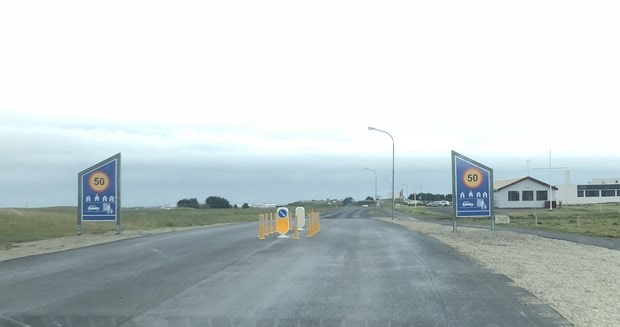

At the entrance to many towns, speed detection devices are installed, and your speed will be displayed on a screen ahead. If you’re within the 50 km/h limit, a green smiley face will appear; if you’re speeding, a red frowny face will show. However, even if you see a red frowny face, don’t worry—this isn’t a speed camera but a reminder that you’ve entered a town and need to slow down.
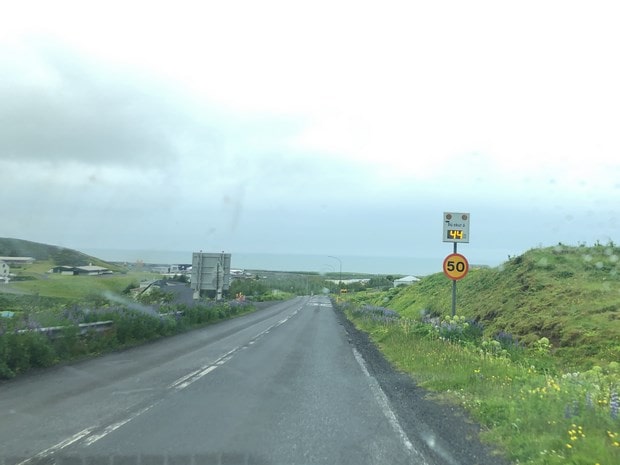

When leaving a town, you’ll see a sign like this, indicating that you’re exiting the urban area, and the speed limit will increase from 50 km/h to 70 km/h and then to 90 km/h.
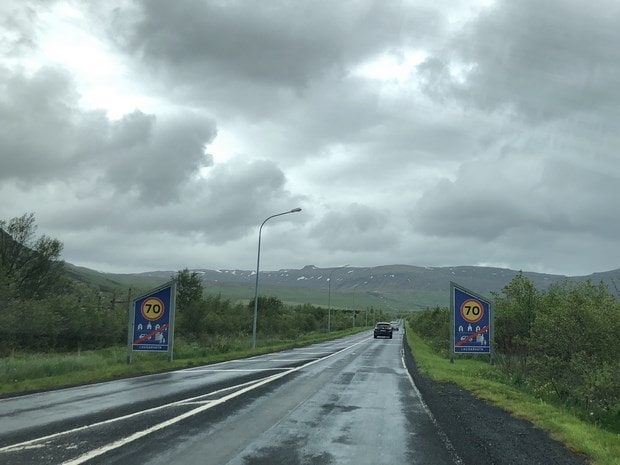

Iceland’s roads have many speed cameras, especially on Route 1. At locations with speed cameras, warning signs are posted several hundred meters in advance.
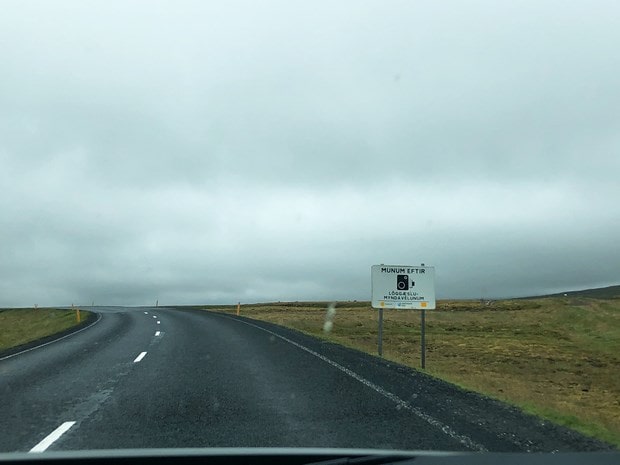

After seeing the speed camera warning sign, you’ll usually spot the camera itself, though sometimes it’s not visible—either because you missed it or it’s a bluff.
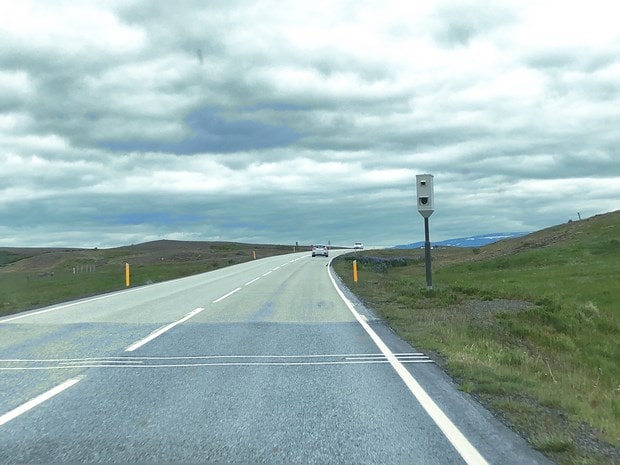

The area with the most speed cameras on Iceland’s roads is near the entrance to the Hvalfjörður Tunnel, the only undersea tunnel in Iceland, located north of Reykjavík. Almost the entire tunnel is monitored by speed cameras, with a speed limit of 70 km/h. When entering the tunnel from the high side, it’s easy to speed, so pay extra attention to your speed.
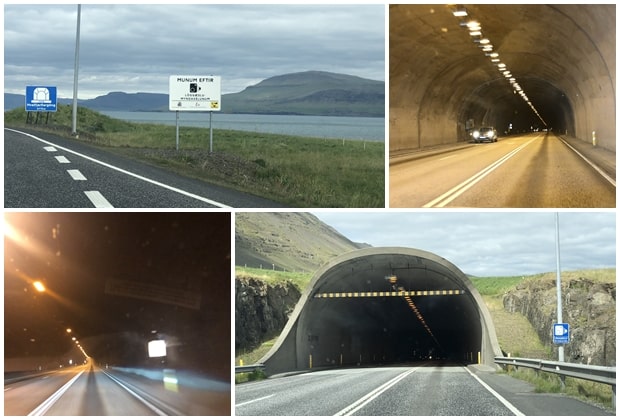

Apart from the Hvalfjörður Tunnel, the stretch of Route 1 between Borgarnes and Reykjavík also has many speed cameras because the road quality is good, the lanes are wide, and it’s easy to unintentionally speed.
5. Traffic Lights, Roundabouts, and Right of Way at Intersections
In Reykjavík, Keflavík (near the international airport), and Akureyri (the largest city in the north), traffic lights are installed at major intersections in urban areas. These traffic lights are the same as ours, with red, yellow, and green signals, and are not complicated. Outside these major cities, traffic lights are virtually nonexistent in Iceland.
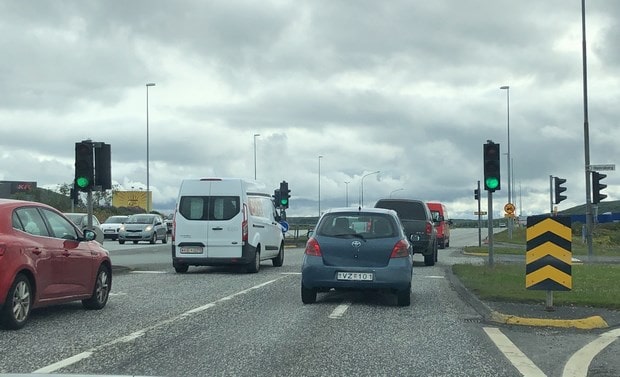

The red lights in Akureyri are designed in the shape of hearts, which is quite cute.
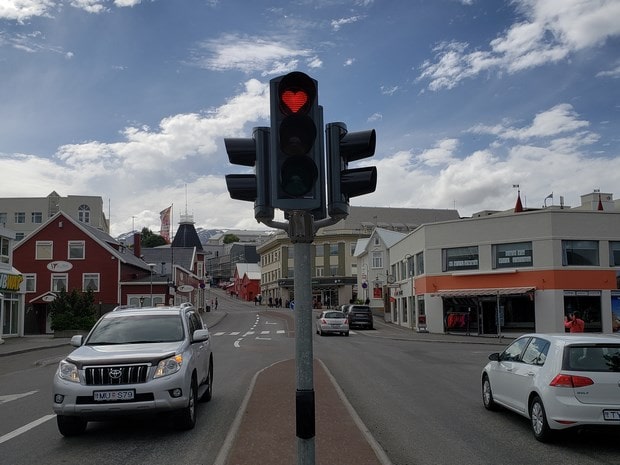

At major intersections without traffic lights, roundabouts (also called traffic circles or rotaries) are used. In roundabouts, vehicles travel counterclockwise, so the rule is to yield to the left. When entering a roundabout, you must stop and check for vehicles approaching from the left. If there are any, yield until they pass before entering the roundabout and exiting at your desired intersection. (Note: The image below is a Google Street View screenshot.)
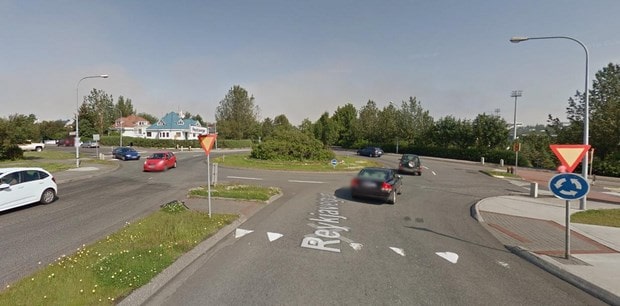

Roundabouts are generally only installed at major intersections. At less important intersections, there are no roundabouts, and you must obey yield signs, usually yielding to the main road. The road with the yield sign will have an octagonal red “STOP” sign or a triangular red-and-yield sign near the intersection. On the approach to the intersection, there will also be a line of white triangles marking where to stop.
Penalties for violating traffic rules in Iceland are severe. For example, failing to yield carries a fine of 20,000 ISK, while running a red light costs 30,000 ISK.
6. Narrow Bridges
Iceland has few large rivers but many small ones. When roads cross these small rivers, bridges are usually built. However, in rural areas, these bridges are often simple, many made of metal, and produce loud noises when driven over. Additionally, these bridges usually have only one lane, barely wide enough for one vehicle. When approaching such bridges, check for oncoming traffic. If there is any, yield to the vehicle closest to the bridge.
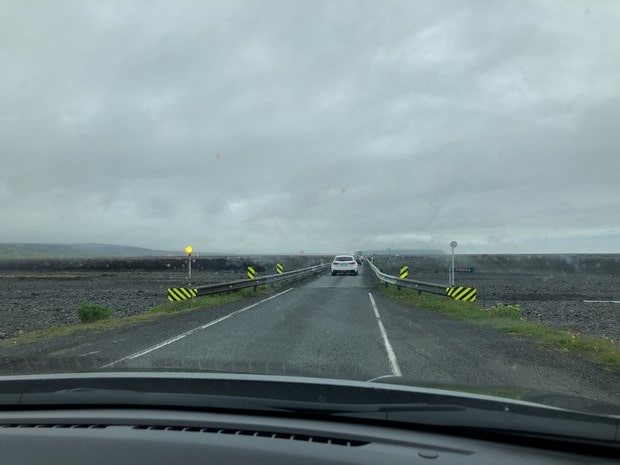

Most narrow bridges on Icelandic roads have flashing lights installed, so you’ll see red flashing lights from a distance, warning drivers of the narrow bridge ahead. Additionally, a few hundred meters before the bridge, you’ll see a narrow bridge sign by the roadside.
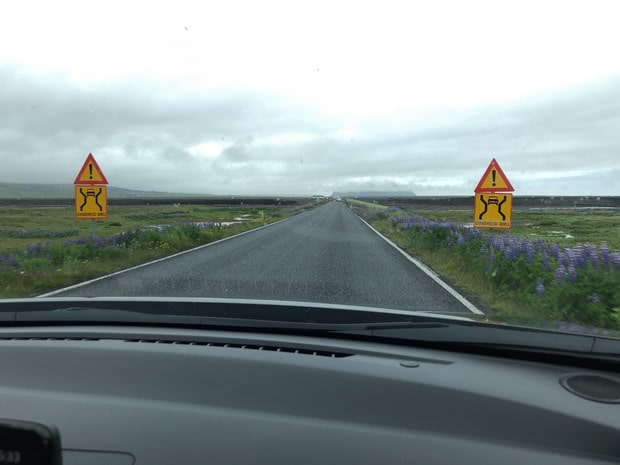

7. Seat Belts and Child Seats
According to Icelandic law, the driver and all passengers must wear seat belts while the vehicle is moving. Drivers or passengers not wearing seat belts can be fined 20,000 ISK. Additionally, children shorter than 1.5 meters cannot sit in the front seat, and those under 1.35 meters must use an appropriate child seat based on their height and weight. Violating these rules carries a fine of 30,000 ISK. For details on child passenger safety regulations, refer to this booklet by the Icelandic Transport Authority.
Car rental companies in Iceland generally provide various types of child seats. If needed, you can rent one when picking up the car or select it during the booking process. The rental fee for a child seat is usually 500–600 ISK per day.
8. Two Hands on the Steering Wheel
Icelandic law prohibits drivers from operating the steering wheel with one hand, so you must always keep both hands on the wheel. This rule is mainly to prevent drivers from using mobile phones while driving. If you need to use a mobile phone while driving, you must use a hands-free device; otherwise, you can be fined 40,000 ISK. Of course, this doesn’t mean you must tightly grip the wheel at all times. If the road is safe and your speed is low, occasionally using one hand is acceptable.
9. Pedestrian Priority
Foreign countries, especially Iceland, place great emphasis on pedestrians’ right of way. In Iceland, many roads don’t have traffic lights, only crosswalks. However, besides yielding to pedestrians at crosswalks, you must yield to pedestrians at any time and place. If you see someone waiting to cross the road, vehicles will stop and wait for them. Failing to yield to pedestrians at crosswalks carries a fine of 20,000 ISK.
Additionally, Icelandic law requires drivers to assist pedestrians in need. Ignoring a pedestrian’s request for help can also result in a 20,000 ISK fine. Of course, this refers to life-threatening situations. Other requests, such as hitchhikers often encountered on Icelandic roads, can be ignored.
10. How to Pay Traffic Violation Fines?
If you violate traffic rules in Iceland and are caught on the spot, you’ll receive a ticket from the police. You can pay the fine immediately or before the deadline at any bank in Iceland or directly at a police station. Icelandic traffic fines offer discounts—paying before the deadline can save you up to 25%.
If you’re caught speeding by a camera, the ticket will usually be issued after you’ve left Iceland. The typical process is: the police notify the vehicle owner (the rental company) of the speeding violation, the rental company provides the renter’s details to the police, and the police email the ticket to the renter. The renter then pays the fine within the deadline using the payment method provided in the email, usually by credit card. Early payment often qualifies for a discount. Additionally, rental companies usually charge a processing fee, which is deducted directly from the credit card you provided when picking up the car. The fee is specified in the rental agreement, typically around 4,000–5,000 ISK.
Of course, since you’re no longer in Iceland, many people choose not to pay the fine. According to data released by the Icelandic government in early 2018, about a quarter of speeding cases caught by cameras go unpaid, most involving foreign self-drive tourists. As a result, the Icelandic government is considering legal changes to hold vehicle owners (rental companies) jointly liable for unpaid fines. If this passes, rental companies may pay the fine first and then charge the renter’s credit card.
3. Classification and Road Conditions of Icelandic Roads
1. Classification and Numbering of Icelandic Roads
Icelandic roads can generally be divided into two types: paved roads and gravel roads. Paved roads include urban streets and major highways connecting towns, while less important roads are usually gravel. Remote highland and mountainous areas often have unpaved dirt roads.
Paved roads in Iceland:
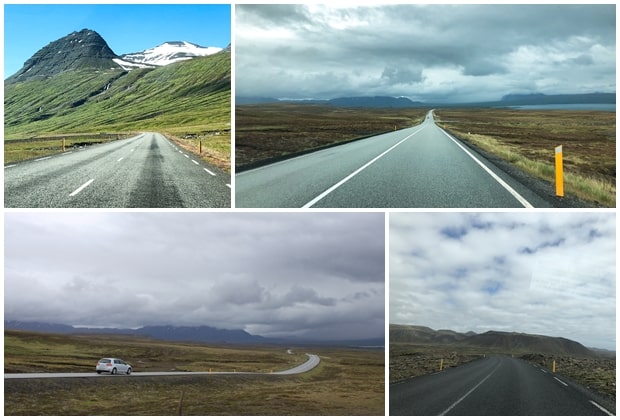

Gravel roads in Iceland:
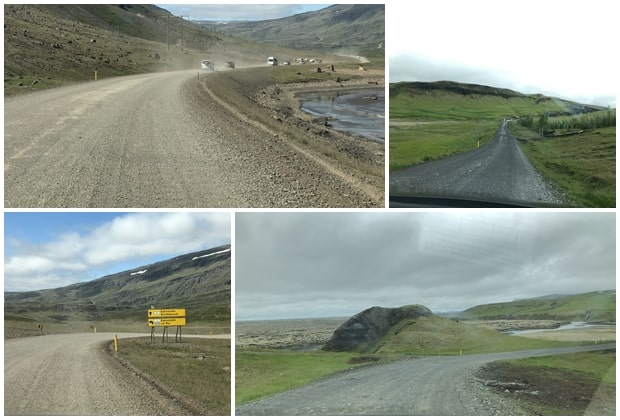

Iceland’s roads are numbered using Arabic numerals, with classifications including single-digit, double-digit, three-digit, and four-digit routes. The fewer digits a road number has, the higher its importance. For example, single-digit numbered roads are national primary highways connecting major towns across Iceland. Currently, the only single-digit numbered road is Route 1 (Route 1), which circles the entire island, linking Iceland’s main towns. Stretching approximately 1,300 kilometers, Route 1 forms a loop around Iceland, earning it the nickname Ring Road. A self-drive tour around Iceland essentially involves following Route 1, with most major attractions located nearby. Thus, Route 1 is the most important road for self-driving in Iceland.
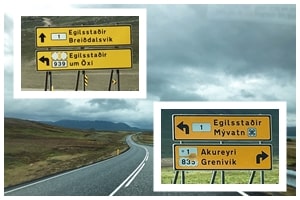

Three-digit numbered roads are less important secondary routes, typically traversing uninhabited areas with low traffic volume. Many attractions in Iceland are located some distance from the main highways, and the roads leading to these sites are usually three-digit numbered routes. With the increasing popularity of self-drive tours in Iceland, traffic on these roads has grown significantly. Some commonly used three-digit roads for self-drivers include Route 365 between Route 36 (Þingvellir National Park) and Route 37 (Geysir), Route 215 to the Black Sand Beach, Route 218 to the Dyrhólaey Peninsula, Routes 862 and 864 to Dettifoss, and Route 848, which loops around the eastern and southern shores of Lake Mývatn.
Four-digit numbered roads are rare, with only two potentially useful for tourists: Routes 8815 and 8816. Route 8815 is a short asphalt road branching off Route 1 to the Mývatn Nature Baths, while Route 8816 is a gravel road from the eastern shore of Lake Mývatn to Hverfjall volcano.
In addition to roads numbered from single to four digits, Iceland also has roads prefixed with the letter F followed by Arabic numerals. These are Highland Roads, leading into the mountainous interior. Highland Roads are primarily found in Iceland’s Central Highlands, and their numbering reflects their importance, with double-digit (e.g., F26, a major highland route from southeast Iceland to Lake Mývatn in the north) and three-digit (e.g., F88 to Askja) classifications.
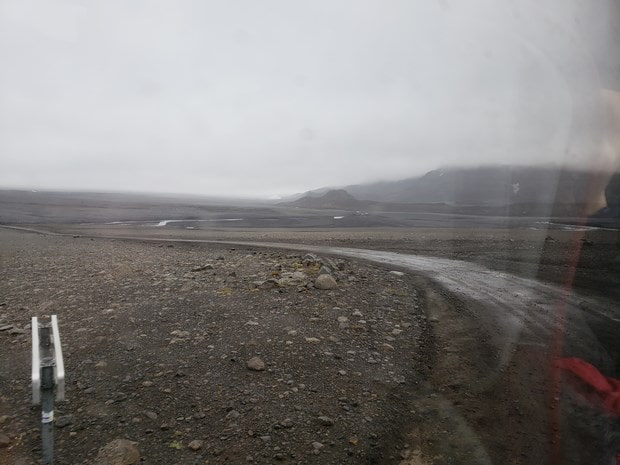

Highland Roads are unpaved and rugged, making them unsuitable for two-wheel-drive vehicles. Driving a two-wheel-drive car on these roads not only voids your car insurance but is also illegal. Rental companies will remind you of this restriction if you rent a two-wheel-drive car. For most tourists, there’s no need to use Highland Roads.
2. Which Roads in Iceland Are Asphalt, and Which Are Gravel?
While road numbering indicates importance, it doesn’t reflect road quality. In other words, the number of digits in a road’s designation doesn’t determine its condition. Route 1, a single-digit road, isn’t necessarily the best; some sections are mediocre, and others are gravel. Meanwhile, many three-digit roads are paved and in better condition than parts of Route 1. Therefore, you can’t judge a road’s drivability solely by its number, nor can you tell whether it’s asphalt or gravel.
To check a road’s surface type, use the Vegasjá website, developed by the Icelandic Road and Coastal Administration. Available in Icelandic and English, the site features a map of Iceland showing all roads: black lines indicate asphalt, while yellow lines denote gravel. The map can be zoomed in or out to inspect any part of the country, though it doesn’t display urban streets.
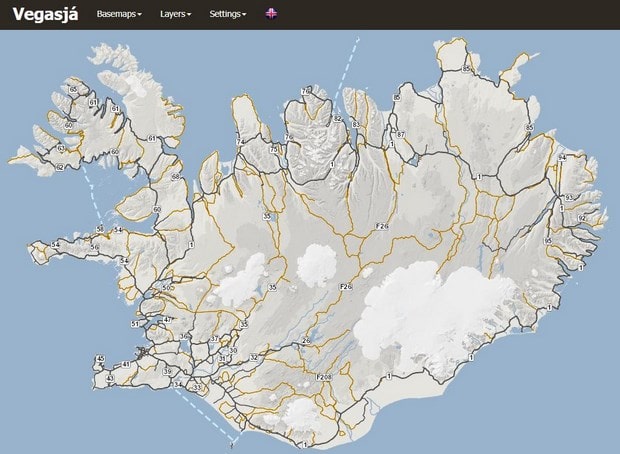

Vegasjá also provides real-time footage from traffic cameras installed along major roads, showing current conditions. Some cameras even display live weather data like wind speed, temperature, and humidity.
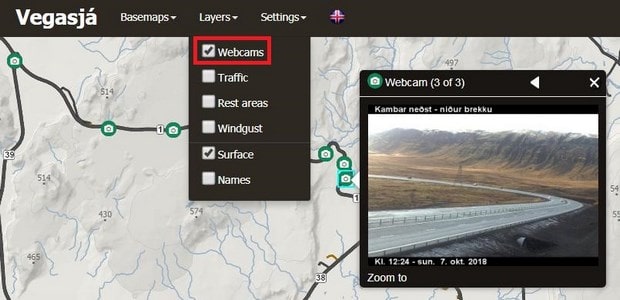

While Vegasjá shows road surface types, its camera coverage is limited. For areas without cameras, you can use another Icelandic site called Já, which offers a feature called Já Map. Similar to Google Maps, Já Map provides standard maps, satellite imagery, and street views—but only for Iceland. It offers more detailed map information than Google Maps, though place names are in Icelandic only, and attractions, restaurants, and shops aren’t marked unless searched for.


Já Map’s satellite imagery is sharper than Google’s in urban and populated areas, though Google performs better in remote regions. Below is a comparison of satellite images around Hallgrímskirkja in Reykjavík: Já Map (left) is noticeably clearer than Google Maps (right).
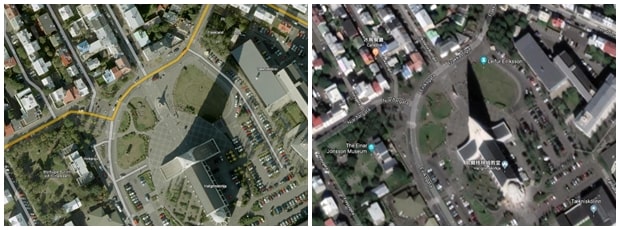

Já Map also offers street views for major roads and urban streets, often with higher clarity and more recent imagery than Google Maps.
3. Checking Real-Time Road Conditions
Vegasjá provides general road statuses, but for real-time updates, use the Road Conditions and Weather page on The Icelandic Road and Coastal Administration website. This page shows current road conditions, such as snowfall, blizzards, sandstorms, closures, restrictions, or construction work. It also color-codes road surfaces to indicate slipperiness, snow cover, and ease of travel.
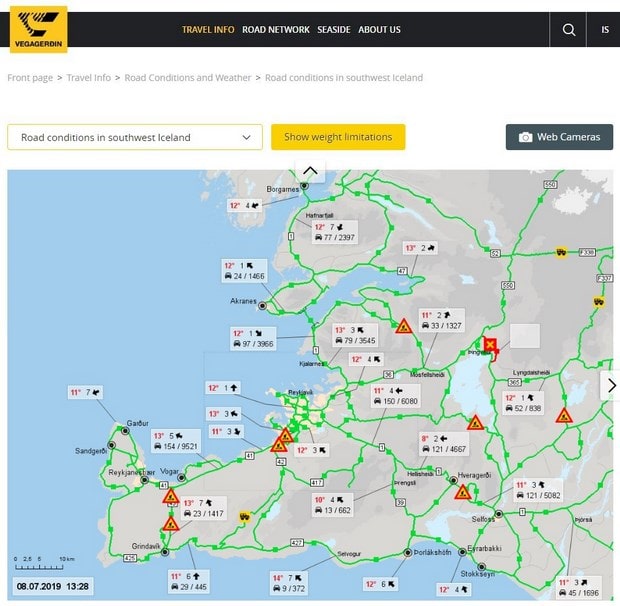

4. Bridges on Icelandic Roads
Iceland has few bridges, and large ones are especially rare. The Skeiðará Bridge, once Iceland’s longest at 880 meters near Vatnajökull National Park’s entrance, was destroyed by glacial floods during a 1996 volcanic eruption. Currently, the longest bridge is the Borgarfjörður Bridge near Borgarbyggð, north of Reykjavík, spanning 520 meters with dual lanes, making it Iceland’s widest bridge.
Apart from these larger bridges, most Icelandic bridges are simple, often made of metal. They produce loud noises when driven over and typically have only one lane, requiring careful navigation. Always check for oncoming traffic before crossing.
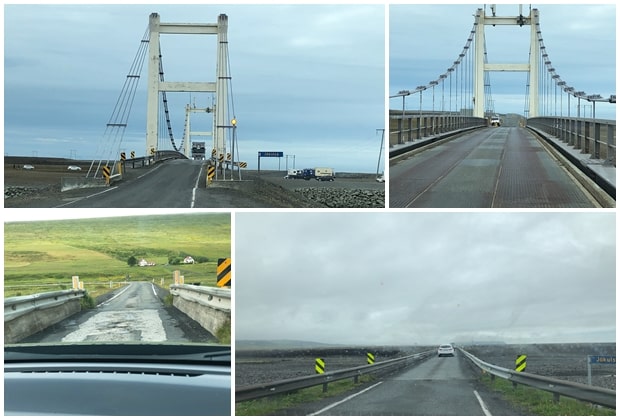

5. Tunnels on Icelandic Roads
Iceland’s roads generally follow mountainous terrain, avoiding tunnels where possible. However, some areas necessitate them. For self-drivers, three tunnels are notable: the Hvalfjörður Tunnel (Iceland’s only undersea tunnel) and two in the Eastfjords—Fáskrúdsfjardargöng (5,900 meters, Iceland’s third-longest) and Almannaskard (1,300 meters).
Icelandic tunnels are raw, with minimal interior finishing—no concrete walls, just exposed rock. Lighting is also dim, giving the feel of a natural cave.
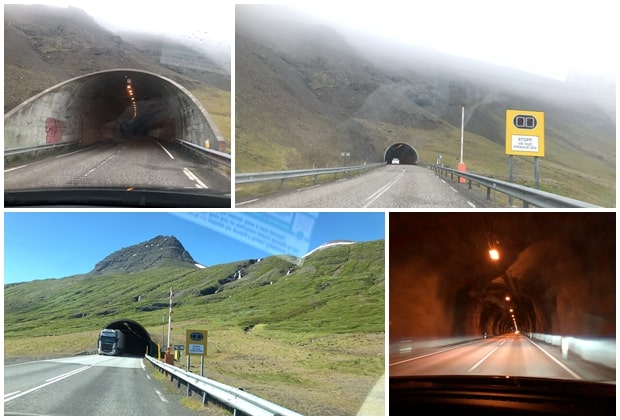

IV. Key Highways and Road Conditions for Self-Driving in Iceland
Most Icelandic attractions are near Route 1, with popular sites concentrated along the southern coast between Reykjavík and Höfn. Many self-drivers circle the island via Route 1, while those short on time often turn back at Höfn. Below are the main roads and their conditions for self-drivers.
1. Reykjavík City Center – Routes 40, 41, and 49
Reykjavík, Iceland’s capital, is home to over 60% of the country’s 340,000 residents. Roads in and around Reykjavík are well-maintained, with all urban streets paved. Major roads like 40, 41, and 49 are high-quality, featuring divided lanes and four to six lanes in some sections. Though not technically highways, they resemble them in quality, with speed limits capped at 90 km/h (50–70 km/h in the city).
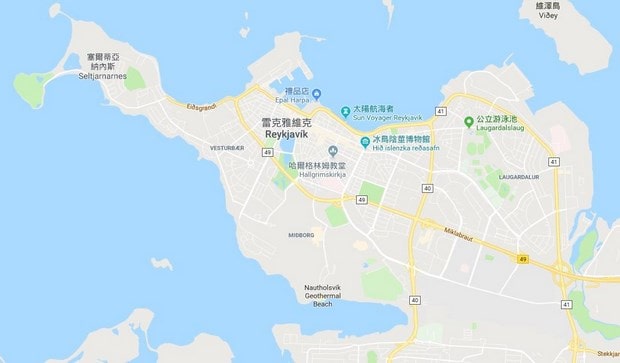

Route 40 is fully paved, with six lanes in parts of Reykjavík and four elsewhere, plus roadside buffers.
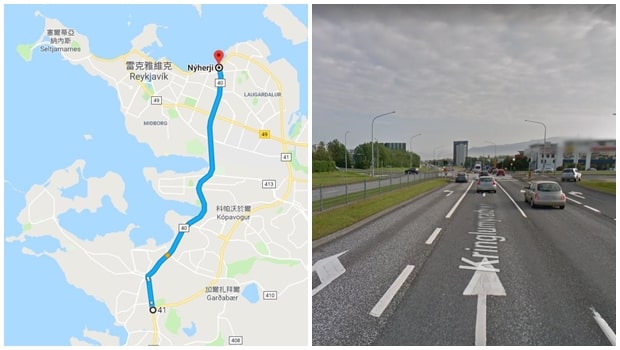

Route 41 connects Reykjavík to Keflavík Airport, splitting into Routes 40 and 41 near the city. Most drivers take Route 40 for a shorter route downtown. Like Route 40, it’s fully paved with divided lanes.
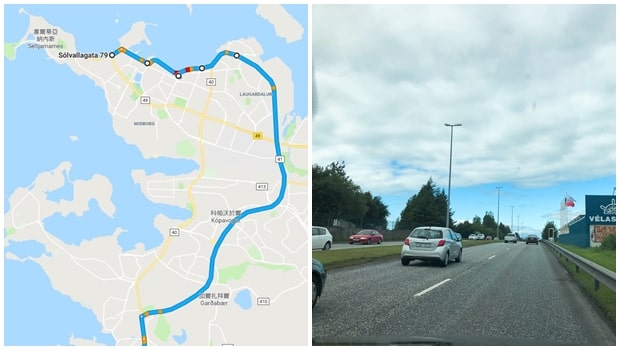

Route 49 links downtown Reykjavík to Route 1, with six lanes in sections and divided lanes. It’s Iceland’s busiest road.
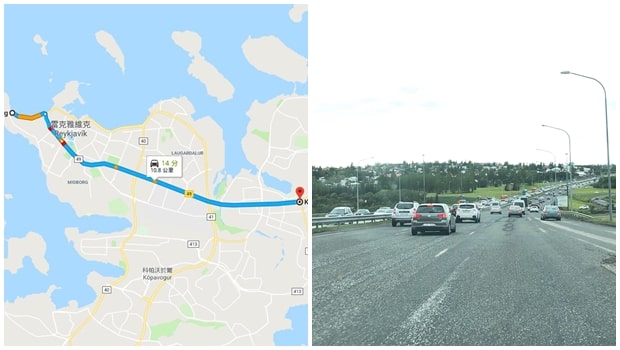

Reykjavík’s streets are all paved, mostly two-lane undivided roads. Traffic is light, and speeds are low (30–50 km/h), making city driving stress-free.
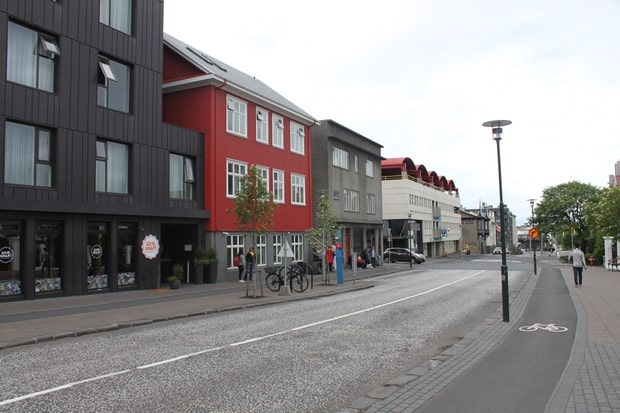

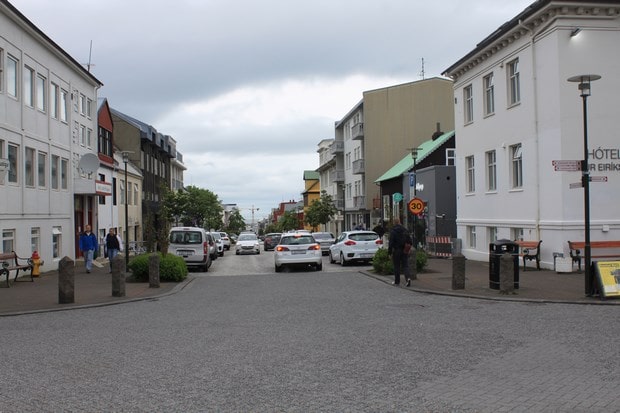

Downtown streets are narrow, with parking on both sides. Many are one-way, so extra caution is needed.
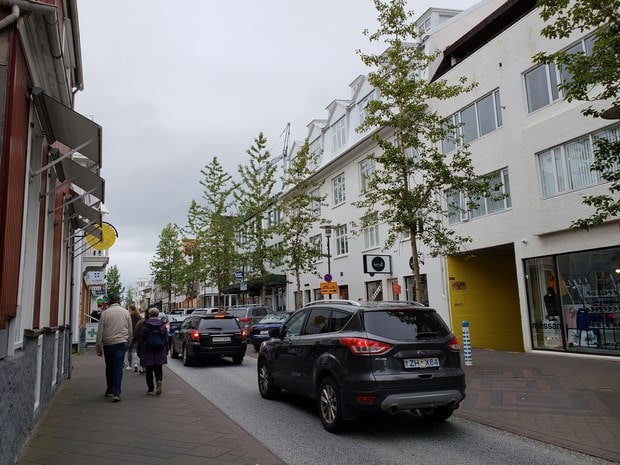

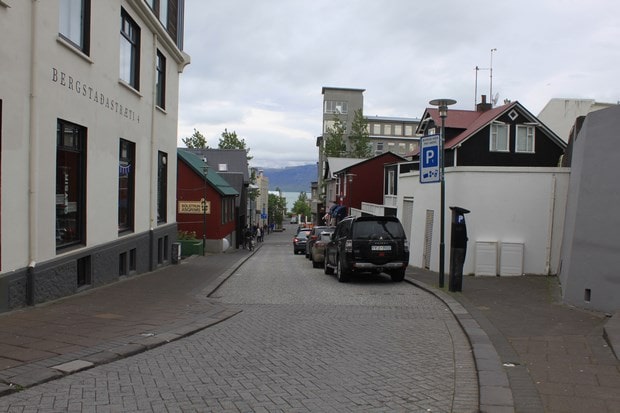

2. Reykjavík to Keflavík Airport – Route 41
Route 41 is the only road from Keflavík International Airport to Reykjavík. Wide and straight, it’s easy to drive—and easy to speed on.
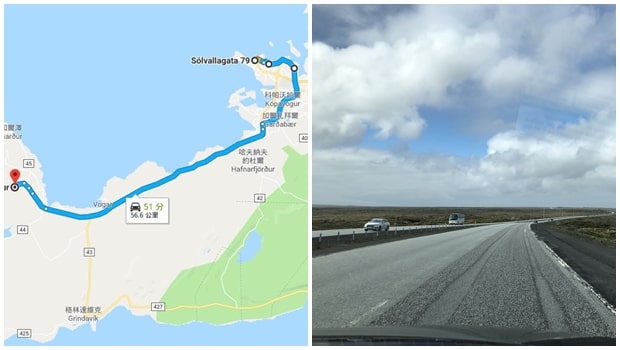

3. The Ring Road – Route 1
Route 1 is essential for any Icelandic road trip. Though Iceland’s most important highway, its quality varies—some sections are gravel.


The 50 km stretch from Reykjavík east to Selfoss is the best, with wide lanes and divided sections.
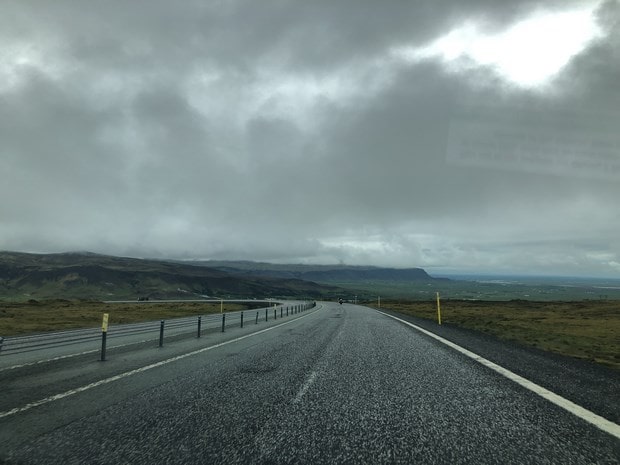

The 70 km section north to Borgarnes is also good, though mostly two-lane. Its wide lanes invite speeding, so watch for cameras.
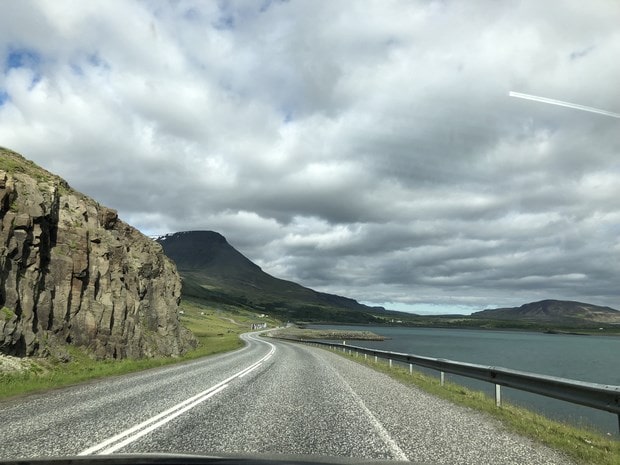

Beyond Selfoss and Borgarnes, Route 1 narrows, with lanes just wide enough for tour buses.
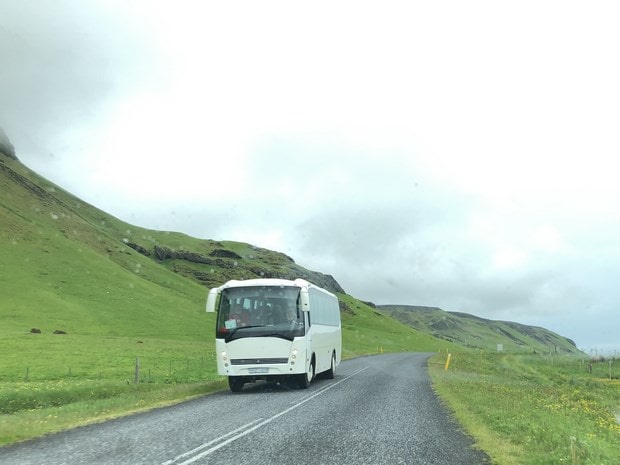

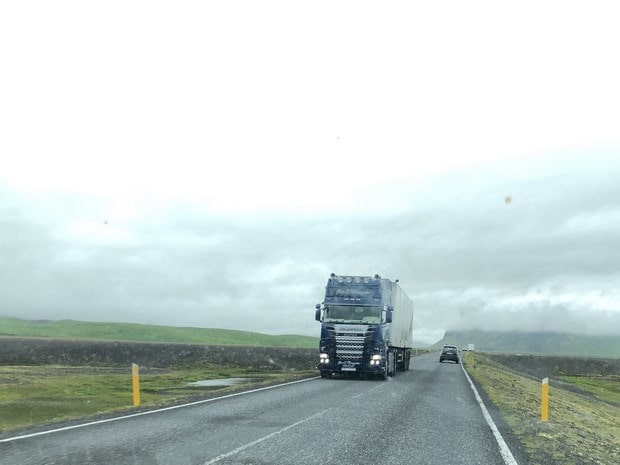

Most of Route 1 is paved, but an 8 km gravel section exists near Djúpivogur in the Eastfjords. Temporary gravel patches may also appear due to repairs.
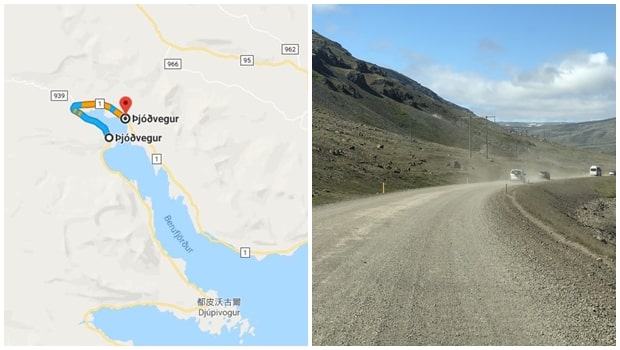

Route 1 showcases Iceland’s diverse landscapes.
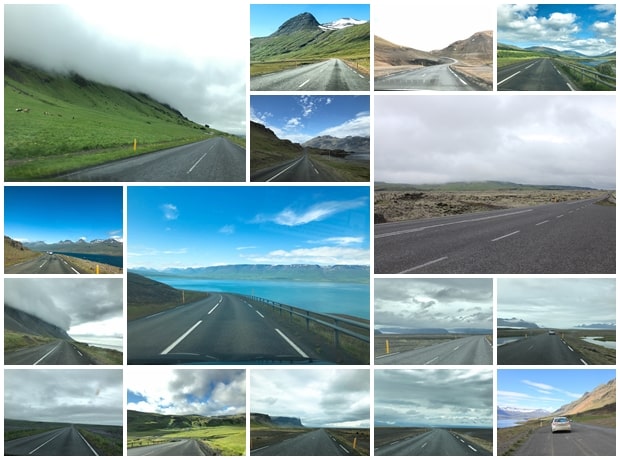

4. Golden Circle – Routes 35, 36, 37, and 365
The Golden Circle includes Þingvellir National Park, Geysir, and Gullfoss (Golden Falls), plus lesser-known sites like Brúarfoss and Kerið Crater Lake. Þingvellir is just 50 km from Reykjavík, while Gullfoss is 130 km away. Many visit these sites on a day trip from Reykjavík, though staying near Selfoss is another option.
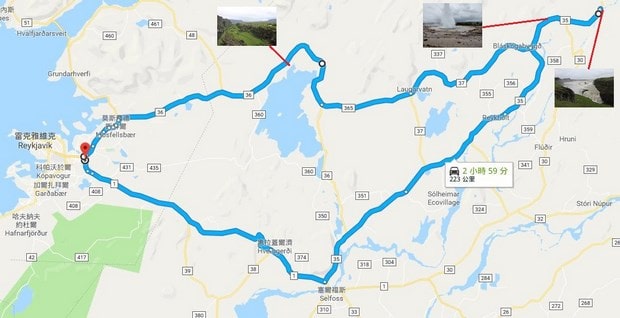

Routes 36, 365, 37, and 35 are all paved but narrow two-lane roads.
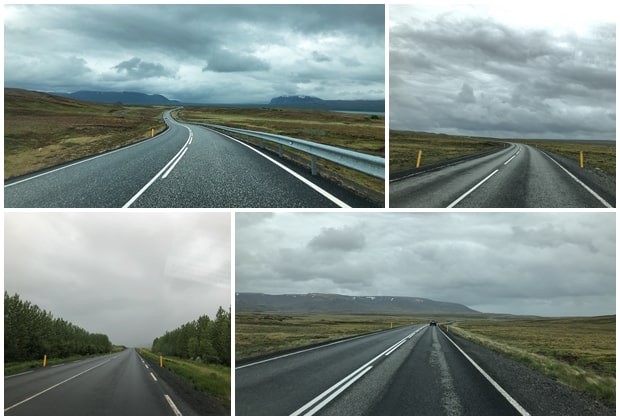

5. Blue Lagoon – Route 43
The Blue Lagoon (Blue Lagoon) near Keflavík Airport is a major attraction. From the airport or Reykjavík, take Route 43 off Route 41. Route 43 is paved and leads to Grindavík, with the Blue Lagoon alongside.
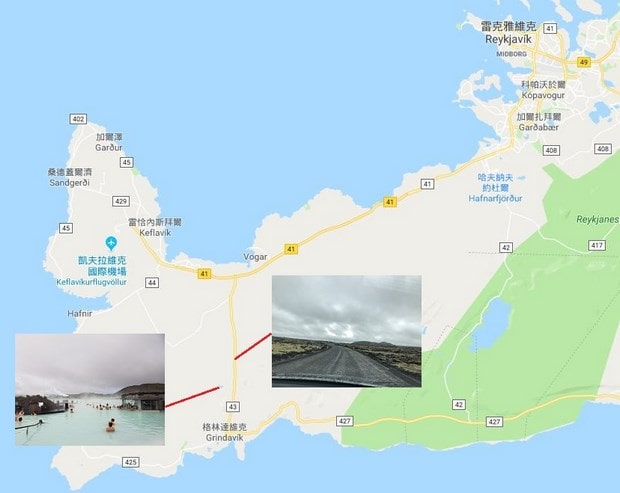

From the Blue Lagoon to Selfoss, Vík, or the Golden Circle, Route 41 to Route 1 is fastest. Alternatively, take Route 427 via Grindavík—a scenic but narrow paved road.
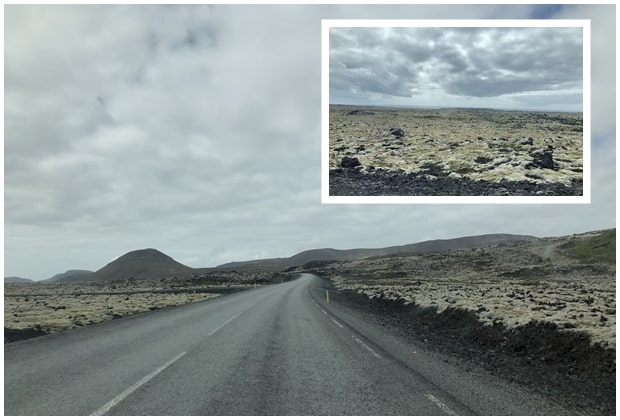

6. Black Sand Beach and Dyrhólaey – Routes 215 and 218
The Black Sand Beach (Reynisfjara) near Vík is iconic. Separated from Vík by a mountain, it’s accessed via Route 215, a narrow paved road.
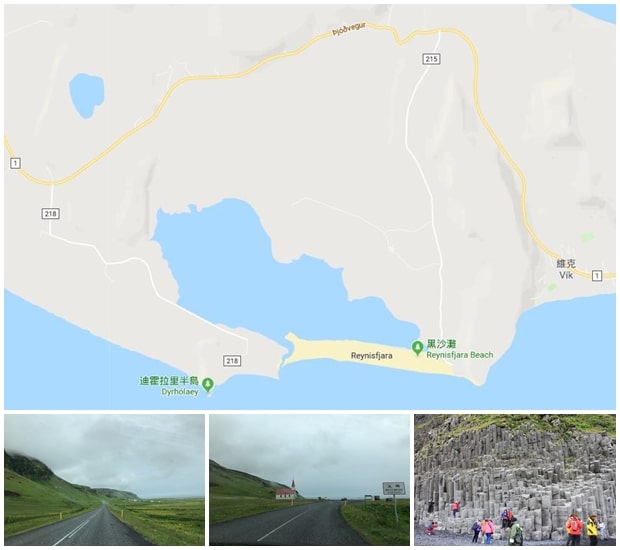

The Dyrhólaey Peninsula, facing the beach, is reached via Route 218, a rougher paved road. The upper viewpoint requires a steep gravel path—avoid it without 4WD.
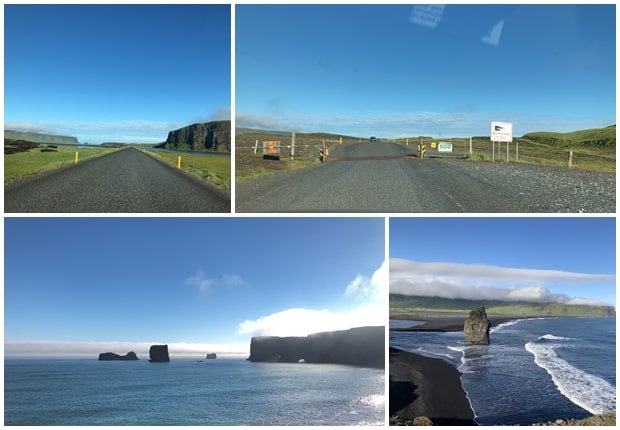

7. Fjaðrárgljúfur Canyon
Fjaðrárgljúfur, 70 km east of Vík, is accessible via a 3 km bumpy gravel path from Route 1.
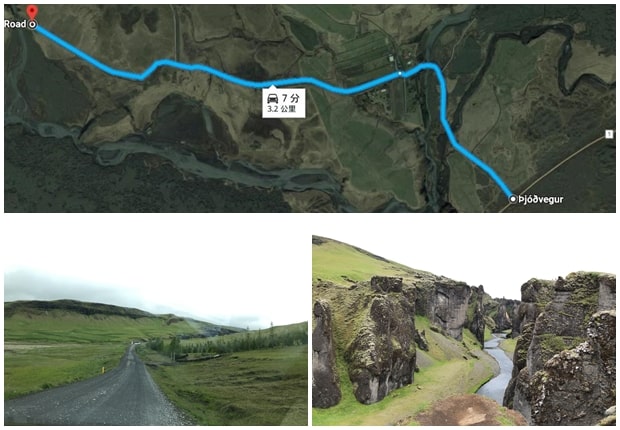

8. Shortcut to Egilsstaðir – Routes 939 and 95
In the Eastfjords, Route 939 from Djúpivogur cuts 60 km off the coastal Route 1 to Egilsstaðir. However, this 19 km gravel road is notoriously rough. Stick to Route 1 for fjord views.
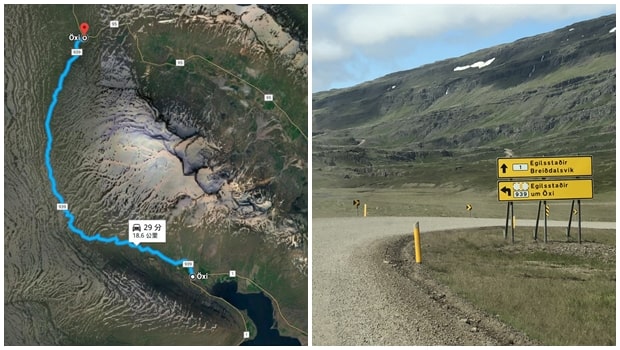

9. Seyðisfjörður – Route 93
Seyðisfjörður, a picturesque fjord town, is reached via Route 93 from Egilsstaðir. Featured in The Secret Life of Walter Mitty, this winding mountain road offers stunning views.
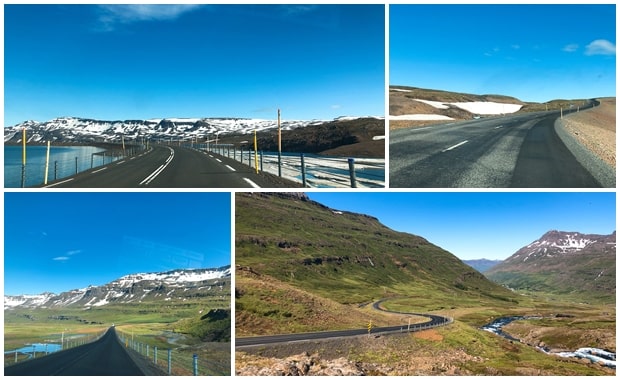

10. Borgarfjörður Eystri – Route 94
The remote town of Borgarfjörður Eystri, a puffin hotspot, is accessible via Route 94 from Egilsstaðir. Half of this 70 km route is gravel.
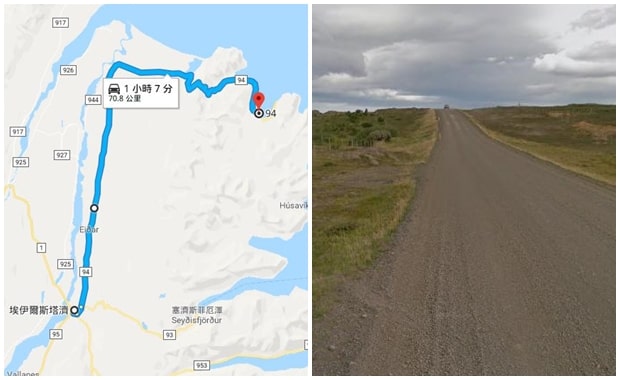

11. Dettifoss – Routes 862 and 864
Dettifoss, Europe’s most powerful waterfall, is accessed via Route 862 (west bank, paved) or Route 864 (east bank, gravel). The west offers a full view; the east gets you closer.
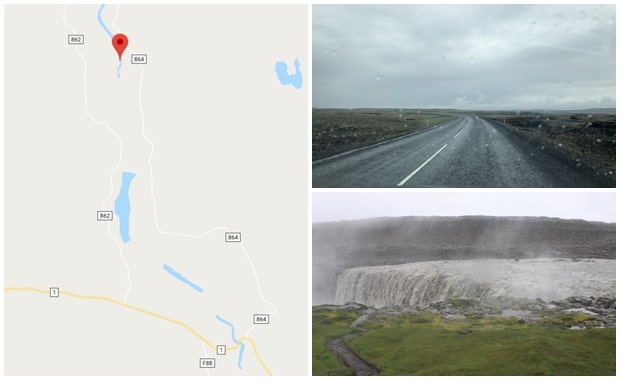

12. Lake Mývatn Area – Routes 848, 860, 863, 864, 8815, and 8816
The Lake Mývatn region is packed with attractions. Route 848 loops the lake, while Routes 863 (Krafla), 8815 (Mývatn Nature Baths), 864 (Dimmuborgir), 860 (Grjótagjá Cave), and 8816 (Hverfjall) branch off. Routes 863, 864, and 8815 are paved; 8816 is gravel; 860 is half-paved.
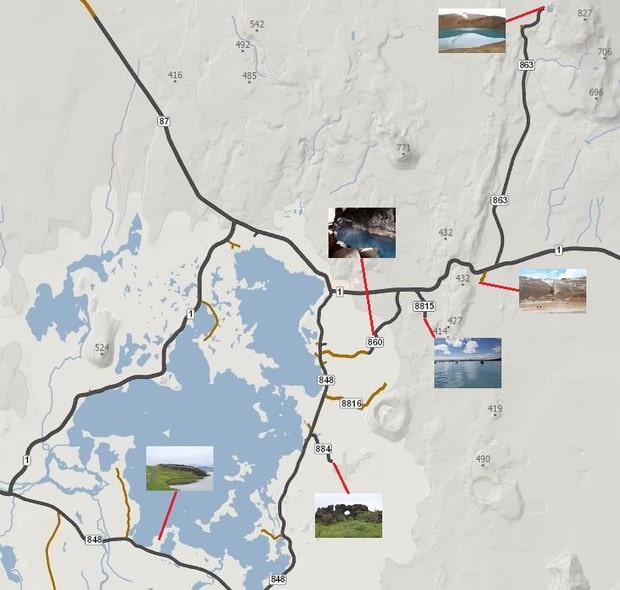

Among these five roads, Routes 863, 864, and 8815 are paved with asphalt, while Route 8816 is a gravel road. As for Route 860, it is half asphalt and half gravel—the section from Route 1 to Grjótagjá Cave is paved, whereas the stretch along the eastern shore of Lake Mývatn to Grjótagjá Cave is gravel. Therefore, it is recommended to approach Grjótagjá Cave from the Route 1 side.
13. Heading to Húsavík – Routes 85, 87, and 845
Húsavík is a famous whale-watching town in northern Iceland. If your itinerary includes a boat trip to see whales, you might visit Húsavík. If you’re traveling from Akureyri to Húsavík, you’ll likely take Route 85. If you’re coming from Lake Mývatn, your GPS might direct you to take Route 87, which includes a roughly 10-kilometer gravel section. To avoid gravel roads, you can first take Route 1, then switch to Route 845, and finally join Route 85. This alternative adds about 20 kilometers to your journey, but Routes 845 and 85 are both paved, making for a smoother drive.
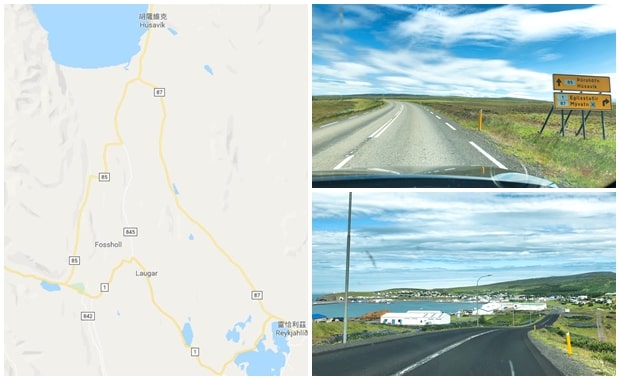

5. Rest Stops, Toilets, and Important Notes for Stopping on Icelandic Roads
Iceland’s roads are lined with breathtaking scenery, so many foreign self-drive tourists can’t resist stopping to take photos. However, the first reminder from Icelandic authorities to foreign drivers is to never stop randomly on the road for photos, even if you pull over to the side. Icelandic roads are generally narrow, and even if you park as close to the edge as possible, your vehicle may still occupy a third or even half of the lane, posing a danger to both yourself and other drivers. If you encounter an unmissable view, make sure to find a spot where your vehicle can be parked completely off the road, without obstructing traffic.
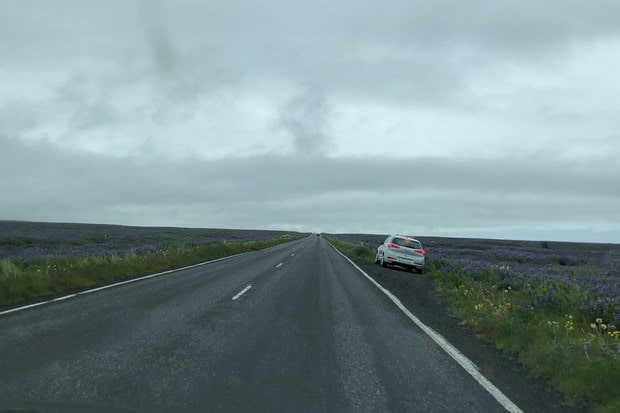

Iceland’s roads also have many rest stops, though they are not as well-equipped as those in other countries with parking lots, convenience stores, and toilets. Most are simple pull-off areas—just a flat patch of gravel by the roadside, often small in size, though a few are paved with concrete. Many of these rest stops double as scenic viewpoints, allowing travelers to stop and admire the surrounding landscape. Some also serve as parking areas for nearby tourist attractions.
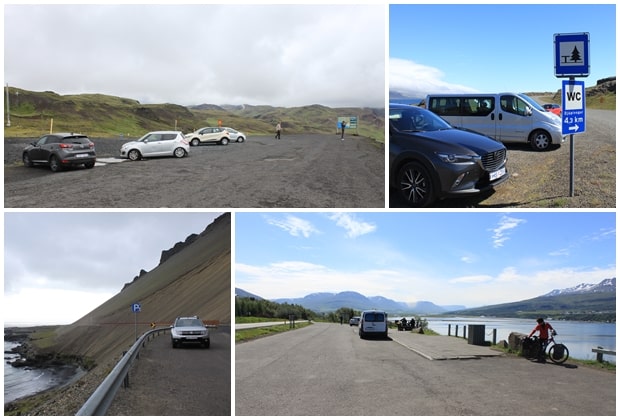

Rest stops may have one or two picnic tables like those found in parks, as well as information boards detailing the local scenery, geology, or history. Some also feature basic toilet facilities.


Rest stops are marked by different signs. Those with tables are typically indicated by a “T” symbol with a tree, while stops with only information boards use an “i” symbol. If it’s just a parking area with no facilities, a “P” symbol is used.
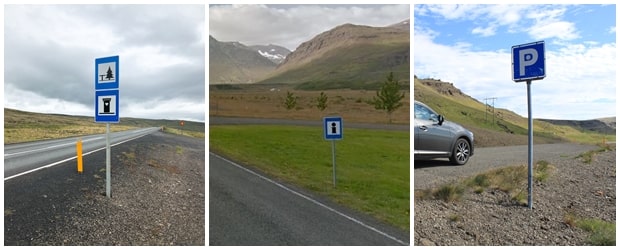

A few hundred meters before a rest stop, you’ll usually see a sign by the roadside indicating the distance to it. If you spot this sign and plan to stop, slow down and keep an eye on both sides of the road. Rest stops have no buildings and are easy to miss. Also, they are only located on one side of the road, so check both your lane and the opposite side.
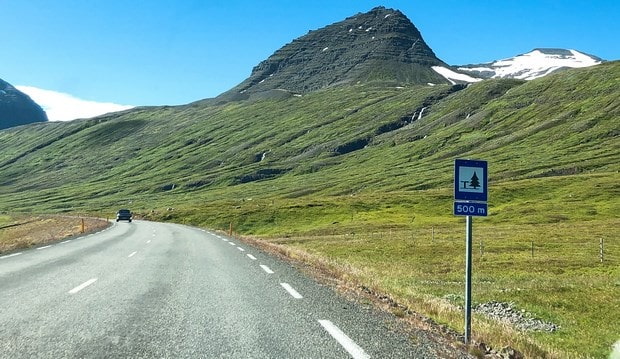

There are about 200 rest stops across Iceland, with over 60 located along Route 1. To plan ahead, you can use the Vegasjá website mentioned earlier. By selecting “Rest areas” in the Layers menu at the top of the map page, rest stop locations will be displayed.
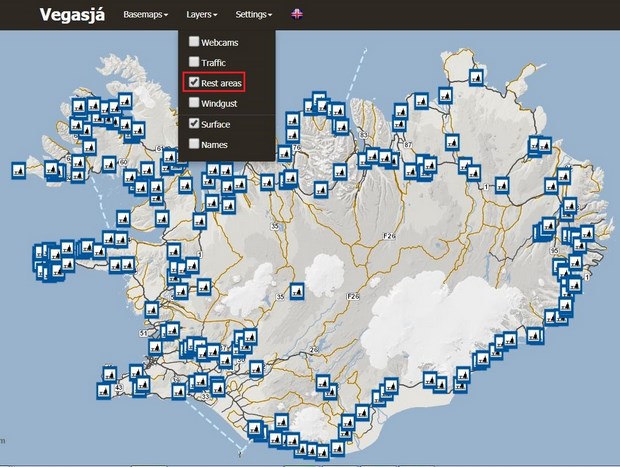

Clicking on a rest stop icon will show details such as its name, the number of tables, toilets, and information boards. To find a rest stop on Google Maps or save its location for navigation during your trip, hover over the icon on the Vegasjá map and note the coordinates in the bottom-right label. Paste these into Google Maps’ search bar to locate it, then save the spot. For example, the coordinates for the rest stop in the image below are 65°27.60’N 15°30.50’W.
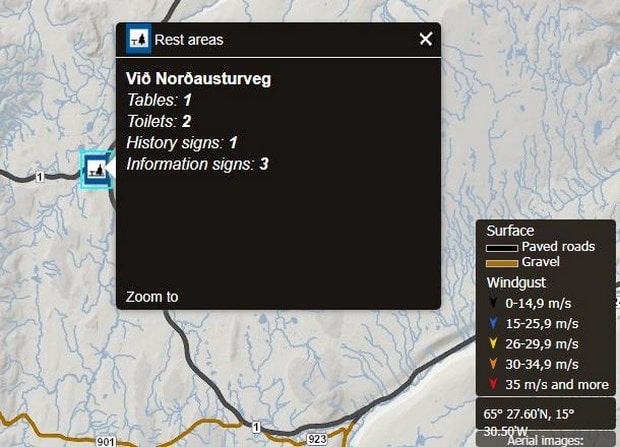

Two physiological needs require special attention during a self-drive trip in Iceland: food and toilets. Iceland is sparsely populated, and finding restaurants outside towns can be challenging. When planning your daily driving route, make sure to identify places where you can eat. If dining options are unavailable, pack snacks or bring a thermos with hot water and instant noodles. Some travelers even carry portable cooking gear for outdoor meals, but be aware that Iceland is often windy, making open-flame cooking difficult.
The toilet situation is trickier, especially for elderly travelers and children. While there are rest stops along the roads, most lack toilets, and those that have them are few and far between. It’s best to use the restroom whenever you find one, even if you don’t feel the urge, to avoid regrets later.
Restaurants and service stations at gas stations usually offer free toilets. Some major tourist sites also have toilets, though they may charge a fee—typically around 100 ISK. Payment can usually be made by credit card or cash, but foreign cards sometimes don’t work, and some places only accept cash. It’s wise to carry some Icelandic króna in cash.
6. Special Considerations for Driving on Icelandic Roads
Iceland’s terrain, weather, and natural environment differ significantly from what many travelers are accustomed to. Most self-drive routes pass through rural areas with relatively basic road infrastructure, making the experience quite different from driving in cities or densely populated countries like Japan or South Korea.
When driving in Iceland, pay special attention to situations rarely encountered elsewhere, such as unique road conditions, sudden animal appearances, strong winds, fog, and other weather phenomena. If you’re visiting in winter, additional precautions are needed for icy roads and hidden hazards beneath snow.
1. Watch for Road Conditions
(1) Beware of Roadside Gravel
Outside major cities, Iceland’s roads are not as well-maintained. Even paved roads often have loose gravel along the edges. Driving too fast can kick up stones, potentially damaging your vehicle. Stay away from the roadside when possible, and reduce speed when passing oncoming traffic.
(2) Avoid Hitting Roadside Poles
Icelandic roads are typically lined with poles spaced about 100 meters apart, likely to mark the road’s edge during winter snow. Poles in the north are taller than those in the south. It’s common to see knocked-over poles, proof that collisions happen frequently. Exercise caution when pulling over to avoid oncoming traffic.
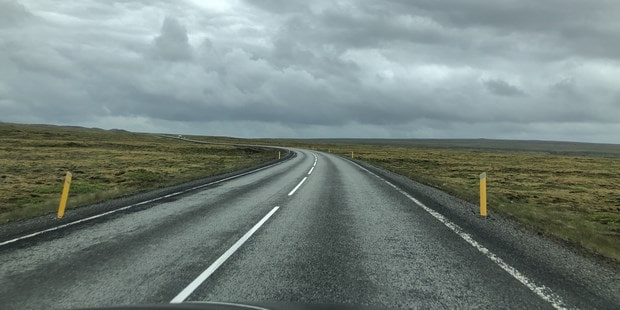

(3) Stay Clear of Roadside Ditches
Icelandic roads are often elevated above the surrounding land. Unless there’s a steep drop, roadsides lack barriers, relying only on poles. It’s easy to accidentally drive into a ditch. While it’s unlikely to happen while driving, most incidents occur when entering or exiting roadside rest areas. Always check the road carefully when pulling over or rejoining traffic.
(4) Slow Down on Gravel Roads
City dwellers rarely drive on gravel roads, so extra caution is needed. The safest approach is to reduce speed. Two-wheel-drive vehicles can handle gravel roads, but wider, thicker tires provide better stability.
(5) Watch for Cyclists
Many people come to Iceland specifically for road cycling. Even in remote areas, you may encounter cyclists—sometimes solo, sometimes in groups, occasionally with support vehicles. Keep an eye out for them.
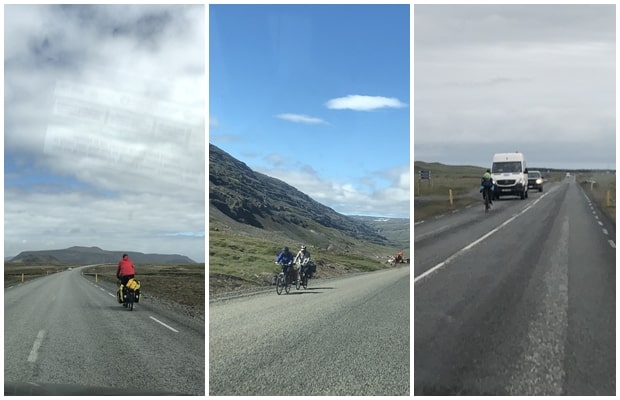

2. Watch for Animals
When driving in Japan, you’ll often see warning signs for various animals, but actual encounters on the road are rare. In Iceland, however, animals on the road are common. If you don’t spot any during your trip, you might be exceptionally unlucky.
Iceland has no dangerous wildlife, so there’s no need to worry about attacks in the wild. The animals you’re most likely to encounter on the road are sheep, with occasional cattle. Horses are usually fenced in and won’t wander onto roads, but sheep roam freely and often cross roads.
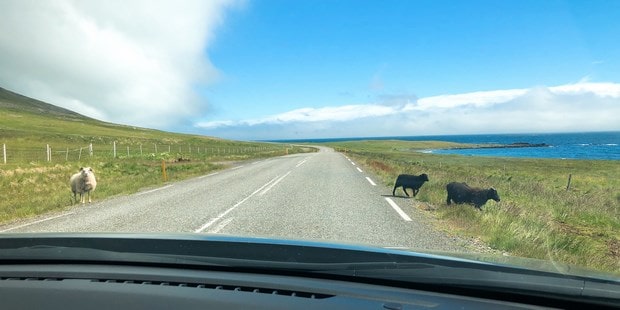

If you accidentally hit a sheep, you’ll need to compensate the owner, so stay alert. However, sheep move slowly and won’t dart onto the road unless startled. As long as you keep your eyes on the road, collisions are unlikely.
Another animal you might hit is birds, and the chances are surprisingly high. Birds often fly low across the road, and if they misjudge your speed, they may collide with your windshield. During my trip around Iceland, at least three birds kamikazed into my car. Fortunately, their small size and low speed mean they usually don’t damage the windshield, leaving only a smudge.
3. Watch for Weather Conditions
Rain and strong winds are common in Icelandic summers, so a windproof and waterproof jacket is essential. Strong winds require extra caution, especially when exiting your vehicle—car doors can be ripped off by gusts. Always park with the front of your car facing the wind to prevent this.
To check wind conditions in your destination, use the Vegasjá website. By selecting “Windgust” in the Layers menu, the map will display wind direction arrows color-coded by speed: black for below 15 m/s (54 km/h), blue for 15–25.9 m/s (54–93 km/h), and yellow, orange, or red for higher speeds.
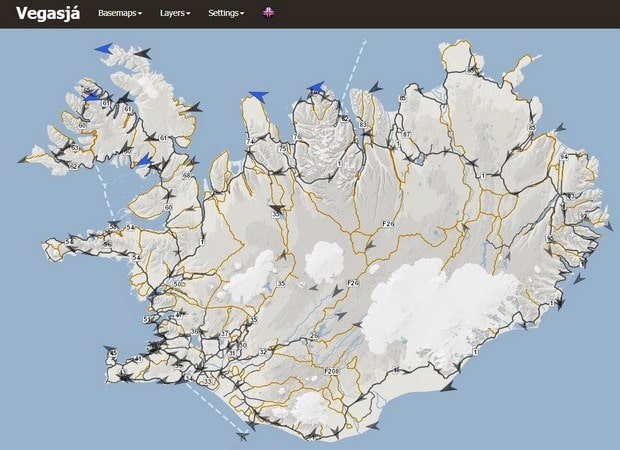

For context, Hong Kong’s Observatory defines a No. 3 typhoon signal as winds of 41–62 km/h. Thus, even the lowest black arrows can indicate typhoon-force winds, while blue arrows exceed that. Only black arrows are safe; other colors signal dangerously strong winds. Summer winds in Iceland usually stay below 15 m/s, but autumn brings stronger gusts.
Fog is another common weather phenomenon, especially in high-altitude areas. During my trip, I only encountered heavy fog once, on Route 1 in the northwest—though it might have been a cloud. If you drive into fog, slow down and proceed with caution.
7. Road Tolls in Iceland
Iceland has no toll roads, except for two tunnels on Route 1: the Hvalfjörður Subsea Tunnel north of Reykjavík and the Vaðlaheiði Tunnel near Akureyri. However, as of September 28, 2018, the Hvalfjörður Tunnel is toll-free.
1. Hvalfjörður Subsea Tunnel
Before September 28, 2018, the Hvalfjörður Subsea Tunnel was Iceland’s only toll road, charging 1,000 ISK per car for a one-way trip. Since then, it has been free to use.
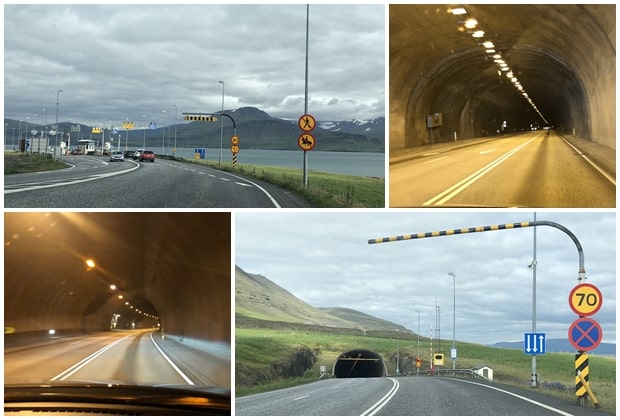

When I visited Iceland in July 2018, the tunnel still had tolls. The photo below shows the toll booth where drivers stopped to pay with cash or credit cards. Now that it’s free, these booths are gone.
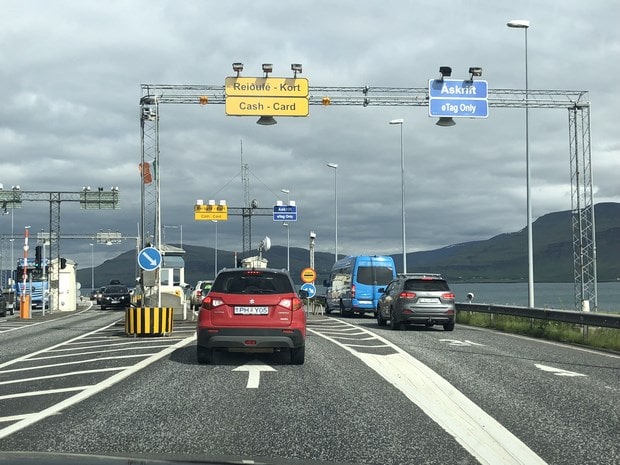

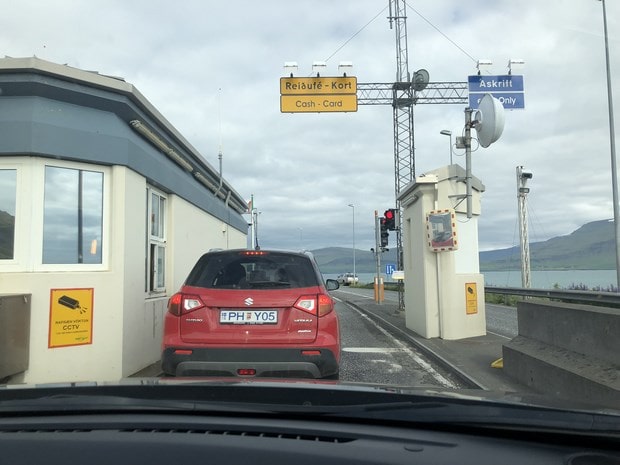

2. Vaðlaheiði Tunnel
The Vaðlaheiði Tunnel, near Akureyri, opened in late December 2018, so it wasn’t there during my July 2018 visit. This 8-kilometer tunnel is located across the fjord from Akureyri. Before its opening, travelers from Lake Mývatn to Akureyri (or vice versa) had to take Routes 84 and 83. The tunnel shortens the distance by about 16 km and saves roughly 12 minutes.
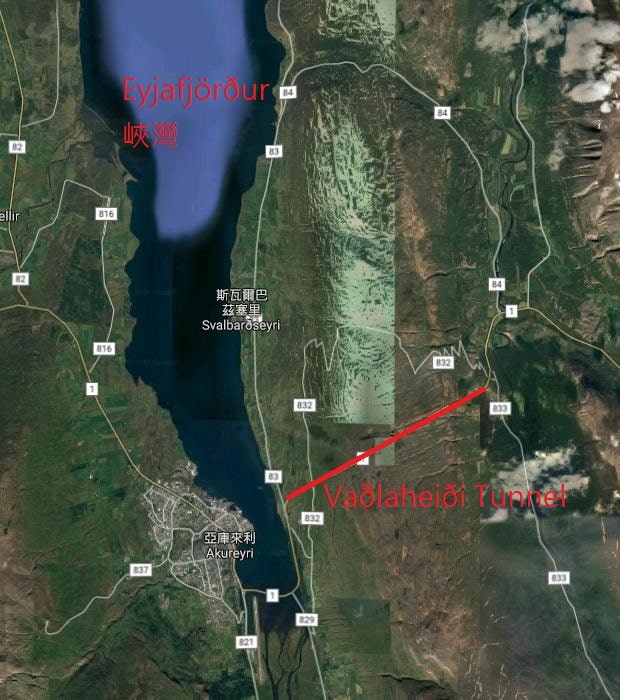

However, if you’re not in a hurry, I recommend sticking to Routes 84 and 83, especially when traveling from Lake Mývatn to Akureyri. Route 84 is a slope offering a stunning elevated view of the Eyjafjörður fjord near Akureyri—one of Iceland’s most scenic drives. The tunnel bypasses this view, and the time saved isn’t significant. That said, in winter, Routes 84 and 83 can be hazardous, making the tunnel a safer choice.
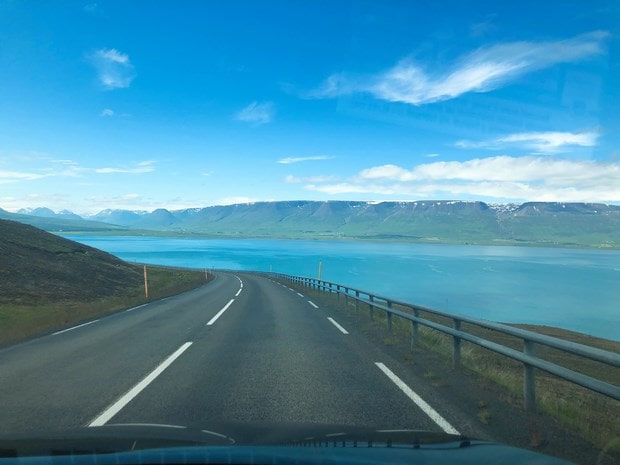

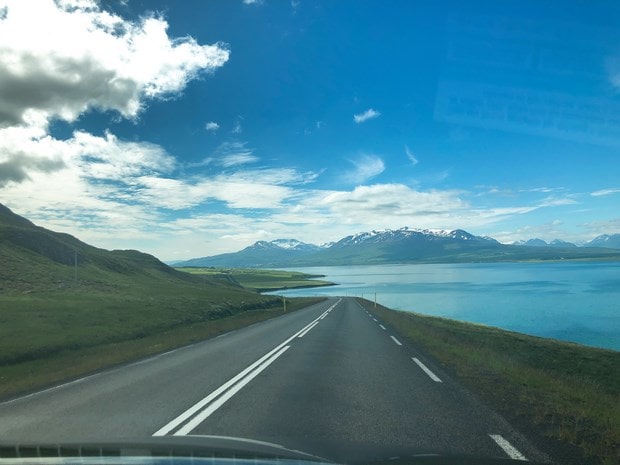

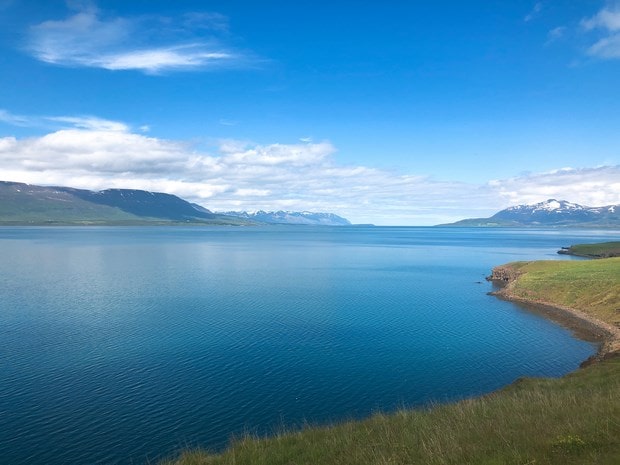

The Vaðlaheiði Tunnel is currently Iceland’s only toll road, charging 1,500 ISK per car for a one-way trip. Unlike traditional toll booths, drivers must pay online within 3 hours of passing through. Late payments incur a higher fee of 2,500 ISK, plus a 1,000 ISK processing charge. For details, visit this page.
8. Parking and Fees in Iceland
Outside Reykjavík’s city center, parking in Iceland is generally free. However, some popular tourist attractions charge for parking.
1. Parking in Reykjavík City Center
Reykjavík’s downtown area is small, with the busiest spots between Hallgrímskirkja and City Hall. This is where most tourists and locals gather, so parking here comes with a fee—and it’s not cheap, ranging from 170–320 ISK per hour depending on the zone and time.
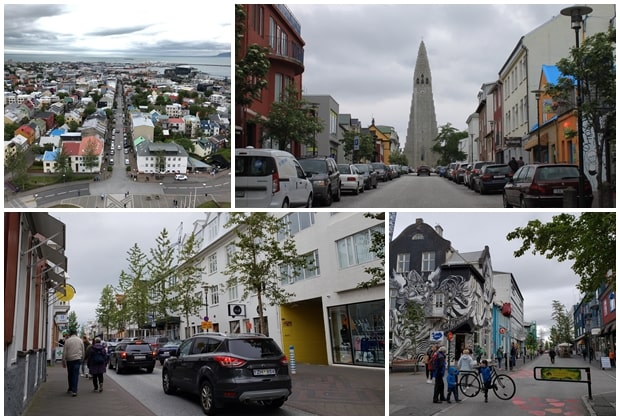

Parking in Reykjavík’s old town is divided into street parking and indoor parking lots. Street parking is more convenient and plentiful, with fees only applying during the day, making it the preferred choice unless you need long-term parking.
(1) Street Parking in Reykjavík
Reykjavík’s street parking is categorized into P1, P2, P3, and P4 zones. P1 is the most expensive at 320 ISK/hour, while P2, P3, and P4 charge 170 ISK/hour (P3 drops to 50 ISK/hour after the second hour).
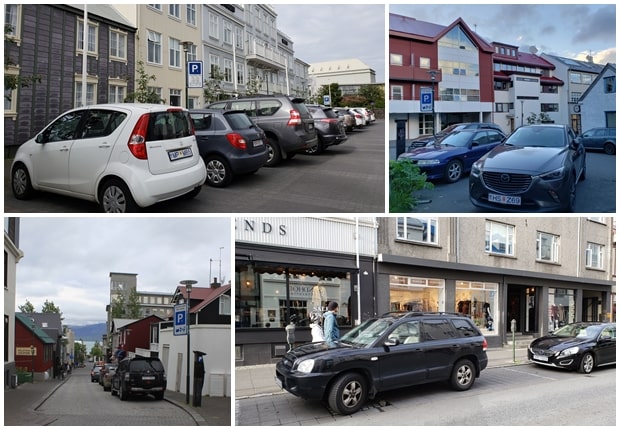

Fee schedules also vary: P1, P2, and P3 operate from Monday–Friday, 9:00–18:00, and Saturday, 10:00–16:00, while P4 runs Monday–Friday, 8:00–16:00. Outside these hours, street parking is free—meaning Sundays and evenings (after 18:00 until 8:00 the next day) are toll-free. During my trip, I avoided parking fees by exploring Reykjavík early or late in the day.
Below is a Google Map by parking authority Bílastæðasjóður, showing fee zones: crimson/pink for P1, blue for P2, green for P3, and orange for P4.
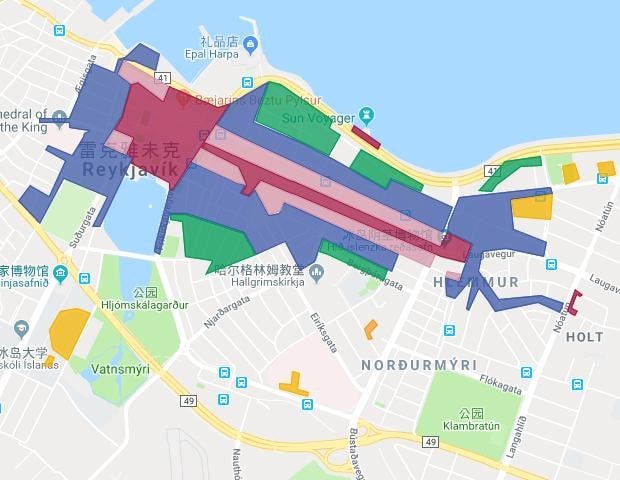

Street parking also falls into two payment types: metered (rare, requiring coins) and Pay and Display (common). For the latter, pay at a nearby machine (cash/credit), print a ticket, and display it on your dashboard.
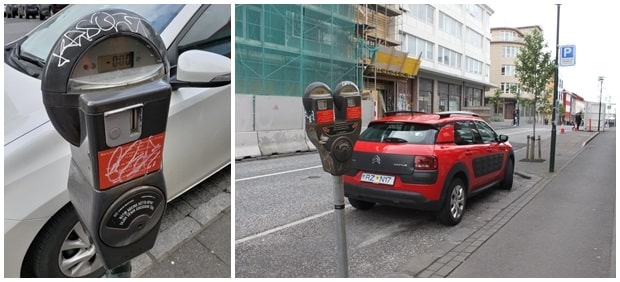

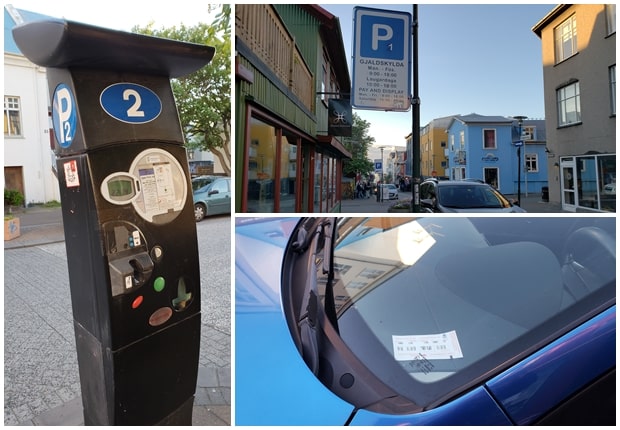

(2) Indoor Parking Lots in Reykjavík
Reykjavík also has indoor parking lots, which are cheaper per hour than street parking but charge 24/7. Since street parking is free at night, indoor lots are only cost-effective for long daytime stays.
These lots operate like standard parking garages: take a ticket upon entry, pay at a machine (cash/credit) before leaving, and insert the paid ticket to exit. Note that they’re not open 24 hours—typically 7:00–24:00.
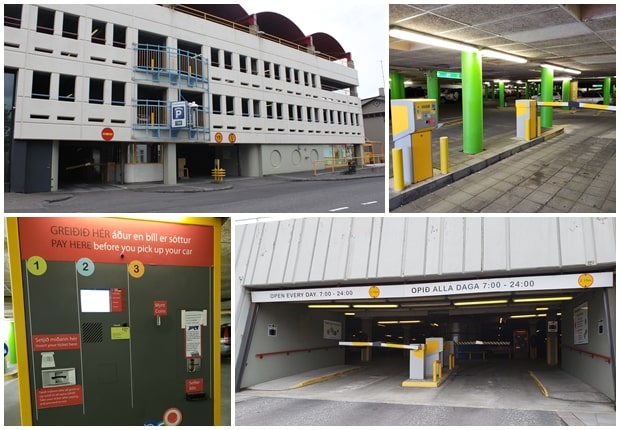

Bílastæðasjóður’s website lists locations, rates, hours, capacity, and real-time vacancies for all indoor lots.
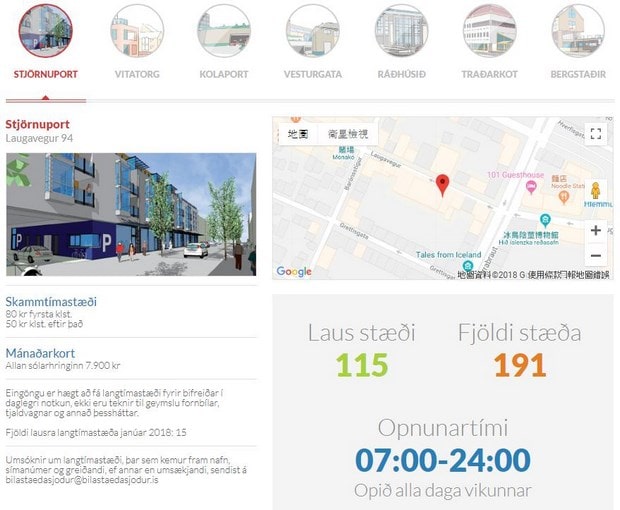

(3) Parking Violations and Fines
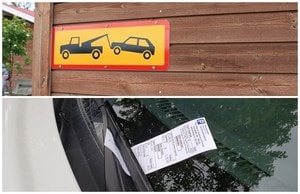

Violations like parking in no-parking zones or on sidewalks carry heftier fines: 10,000 ISK (8,900 ISK if paid early), maxing out at 20,000 ISK.
The steepest fines—20,000 ISK (18,900 ISK early)—apply to parking in disabled spots, doubling to 40,000 ISK if unpaid.
Fines can be paid at any bank. If ignored, rental companies will pay on your behalf and charge your card, plus a ~5,000 ISK handling fee.
2. Parking in Akureyri City Center
Akureyri, northern Iceland’s largest town (population ~18,000), has a compact downtown where parking is free. However, daytime parking (usually 10:00–16:00) is time-limited (15 mins to 2 hours). Exceeding this risks a fine, payable at banks.
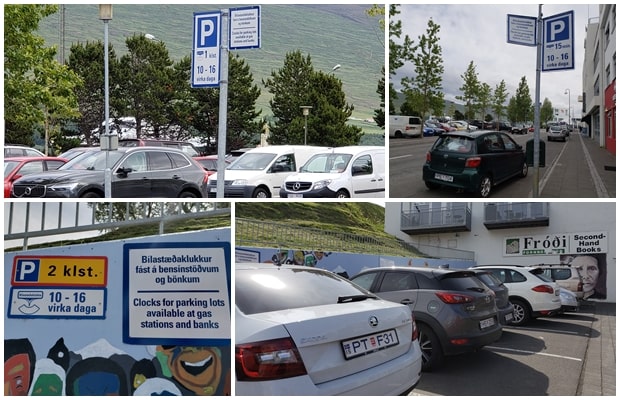

To comply, use a free paper parking clock (available at gas stations, visitor centers, or shops) or write your arrival time on paper and display it on your dashboard.
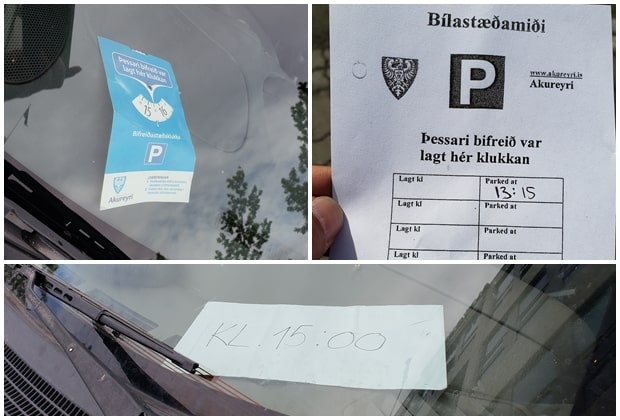

Failure to display your start time may result in a fine, though police presence is minimal.
3. Parking at Tourist Attractions
Most Icelandic attractions are in remote areas with free informal parking. However, popular sites like Þingvellir National Park, Seljalandsfoss, and Vatnajökull National Park charge 500–700 ISK per day, functioning as entry fees.
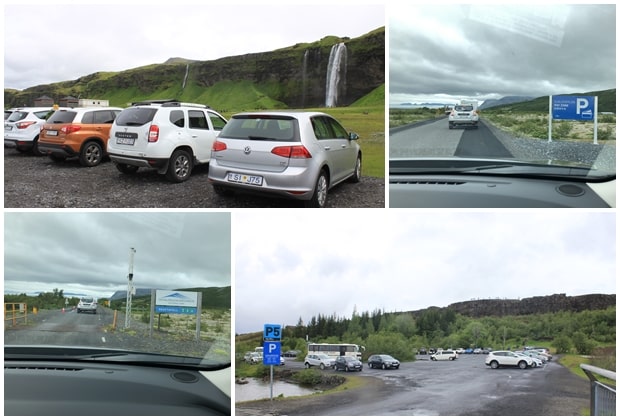

Payment methods vary. At Þingvellir and Seljalandsfoss, use credit cards at onsite machines and display the printed ticket. Some machines reject foreign cards; if so, pay at visitor centers instead.
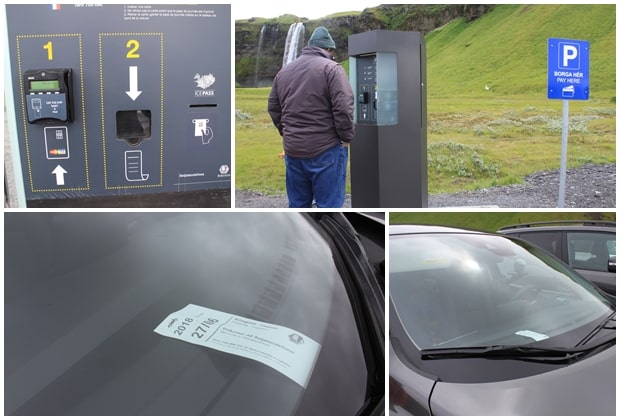

Most parking fee machines in Iceland accept internationally issued credit cards like VISA and MasterCard, but there are exceptions. For example, when we parked at Þingvellir National Park, none of our credit cards worked at the payment machine, and other foreign tourists faced the same issue—only Icelandic credit cards were accepted. If you encounter this problem, don’t worry. If an inspector finds your car without a displayed parking ticket, they will leave a notice on your windshield. You can simply pay the parking fee at the visitor center by the end of the day.
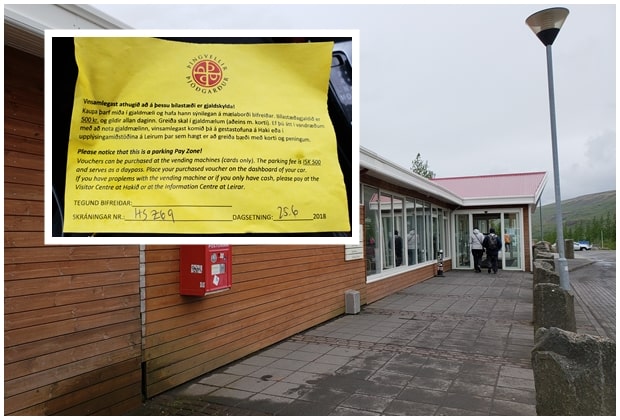

The parking payment system at Vatnajökull National Park is slightly different. A camera records your license plate when you enter the parking area. Before leaving, you need to pay the parking fee at the visitor center inside the park. Payment can be made at the service counter or using the self-service computers. Enter your license plate number during the process, and once paid, you won’t receive a receipt, but the system will record the transaction. You can then drive out without further steps.
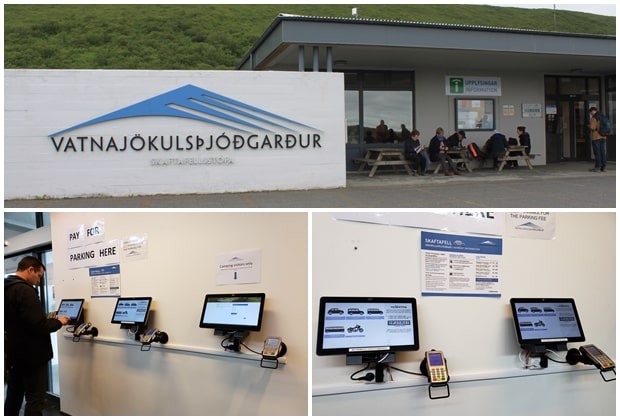

9. Refueling
1. Gas Prices and Fuel Budget in Iceland
Gas prices in Iceland are relatively high, with unleaded gasoline typically costing between 200–230 ISK per liter. Fuel expenses are one of the major costs of a self-drive tour in Iceland. For example, during our 11-day road trip around the island covering over 2,300 km, we spent approximately 35,000 ISK on fuel, averaging 15 ISK per kilometer. This figure applies to compact cars; if you’re driving a larger vehicle like a 7-seater, SUV, or 4WD, the cost per kilometer will likely be higher than 15 ISK.
To check the latest gas prices in Iceland, visit this website, which provides real-time prices for gasoline (95 Octane) and diesel at major gas stations across the country.
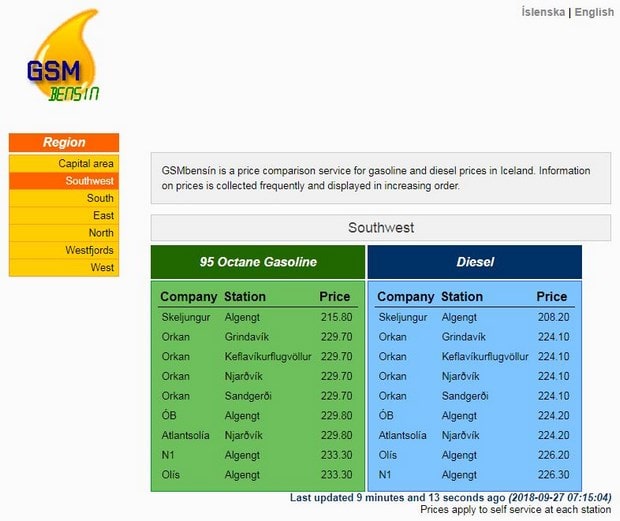

2. Major Gas Station Companies in Iceland
There are about seven or eight gas station companies in Iceland, including N1, Olís, ÓB, Skeljungur, Orkan, Atlantsolía, Dælan, and Costco. Some of these companies are interconnected; for example, Orkan operates under Skeljungur as a sub-brand, while Olís and ÓB are two brands under the same company.
Prices vary between companies and even between brands under the same company. However, prices are generally consistent nationwide for the same brand—for instance, N1 stations charge the same price across Iceland. Among these, Skeljungur typically offers the lowest prices, followed by Dælan, while N1 and Olís are usually the most expensive. Atlantsolía, Orkan, and ÓB fall somewhere in between.
Additionally, Costco, a wholesale supermarket, also operates gas stations with reportedly the lowest prices. However, Costco is membership-only, requiring an annual fee, and has only one location in Iceland—in Garðabær, south of Reykjavík. Even if you have a membership, the savings might not offset the extra fuel and time spent driving there and back.
(1) N1 Gas Stations
Among Iceland’s gas companies, N1 is likely the largest, with over 150 stations nationwide. In many remote areas, N1 is often the only option. Another advantage for foreign tourists is N1’s prepaid fuel cards, which make refueling more convenient. Despite higher prices, most international visitors opt for N1 stations. During our trip, we primarily refueled at N1.
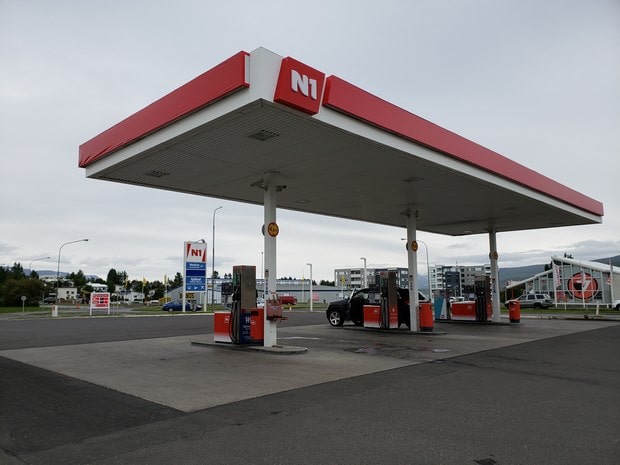

N1’s prepaid cards can also be used at Dælan stations, which are cheaper. However, Dælan has only three locations, all in Reykjavík, so we didn’t encounter any during our trip.
(2) Skeljungur and Orkan Gas Stations
While Skeljungur offers the lowest prices, its stations are scarce—only nine nationwide, mostly in Reykjavík, with one each in Akureyri and Hveragerði. However, its sub-brand, Orkan, has 56 stations (including Orkan X) across Iceland, though all are small, unattended self-service stations.
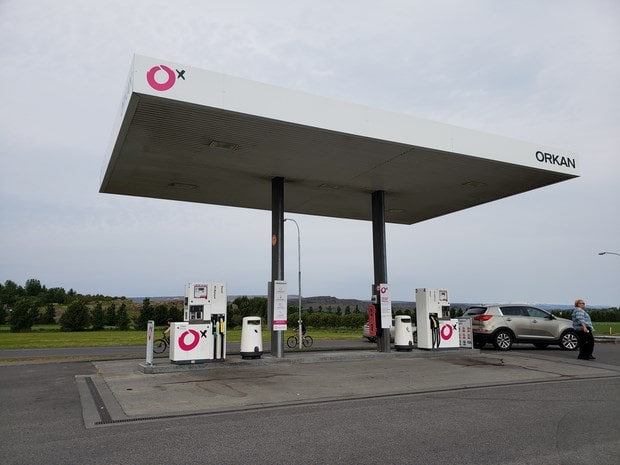

Like N1, Skeljungur offers prepaid fuel cards, usable at both Skeljungur and Orkan stations, making them convenient for foreign travelers. Although Skeljungur and Orkan combined have far fewer stations than N1, they are present in most major towns. With proper planning, you can easily find an Orkan station before running out of fuel. Locations can be checked on this webpage’s Google Map.
Skeljungur and Orkan prices are about 7% and 2% cheaper than N1, respectively. If you’re mainly driving around Reykjavík, using Skeljungur could save you around 7% on fuel. For a full island tour, combining Skeljungur and Orkan stations could average a 3% saving compared to N1. In absolute terms, the savings aren’t huge—for our 11-day trip, using mostly N1, total fuel costs were about 35,000 ISK, so 3% would be around 1,000 ISK. For short-term visitors, chasing the cheapest stations may not be worth the effort.
(3) Olís and ÓB Gas Stations
Olís prices are similar to N1, while ÓB is slightly cheaper (1–2% lower). Although not the cheapest overall, Olís and ÓB offer discount cards (or keychain tags) that provide a 3 ISK per liter discount (about 1%). Many car rental companies provide these cards to customers. However, Olís and ÓB don’t offer prepaid cards, which can be inconvenient for tourists.
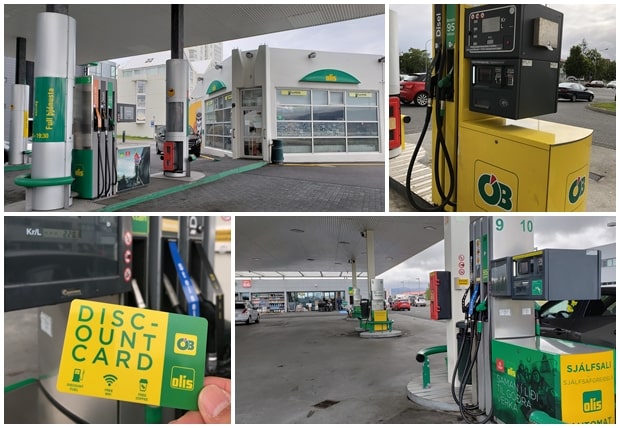

Olís has 35 stations nationwide, while ÓB has 38, totaling 73 locations. You can check their station locations here.
3. How to Refuel and Pay
Due to Iceland’s small population, all gas stations are self-service. Refueling is straightforward: open the fuel cap, insert the nozzle into the tank, hold it firmly, and wait until the tank is full. You’ll hear a “click” when the nozzle automatically stops. Then, remove the nozzle, return it to its place, and close the fuel cap.
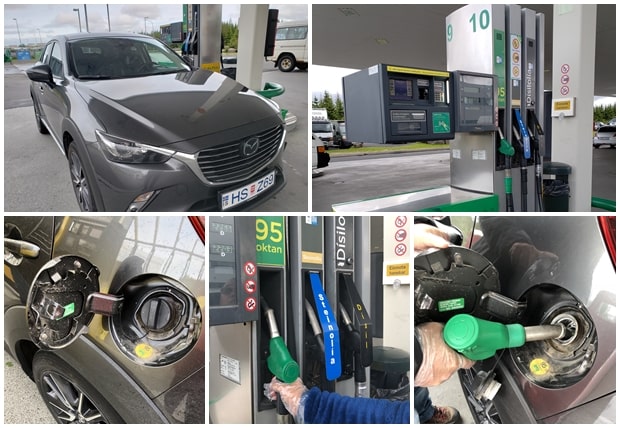

Icelandic gas stations typically offer only two options: gasoline (Bensín) and diesel (Dísel). A few may also carry kerosene (Steinolía). Gasoline is always 95 octane, so mistaking fuel types is unlikely. Most cars use gasoline, but if you rent a 4WD, it might require diesel. The fuel type is usually labeled on the fuel cap or inside the tank door.
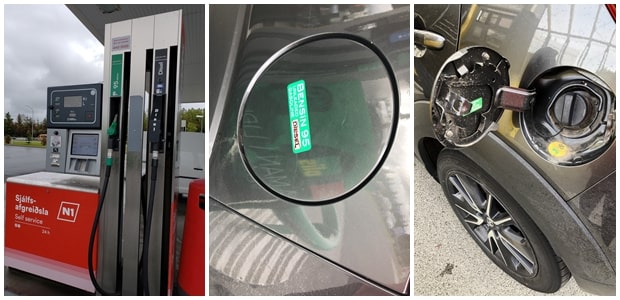

The biggest challenge when refueling in Iceland is payment. Stations are fully self-service, with no staff to assist, and payment is typically credit card-only. However, most pumps only accept Icelandic credit cards. Foreign cards usually don’t work, unless the station has a service shop where foreign cards are accepted.
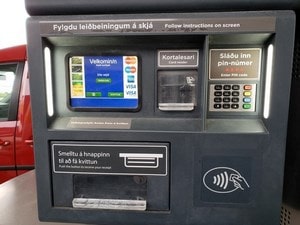

If you’re curious, you can try using your foreign card at a self-service pump, but don’t rely on it. Most attempts will fail, wasting time. Experiment once or twice at most.
To use a credit card at the pump, insert it into the card slot (select English if prompted), then enter your 4-digit PIN. If accepted, the machine will prompt you to select a pump or choose between a full tank or a fixed amount. Follow the instructions, insert the nozzle, and you’ll hear fuel flowing.
In larger towns like Reykjavík or Akureyri, some stations have service shops (convenience stores) where you can pay with cash or foreign cards. At these stations, you can park at a pump, go inside, and ask the staff to unlock it. After refueling, return to pay.
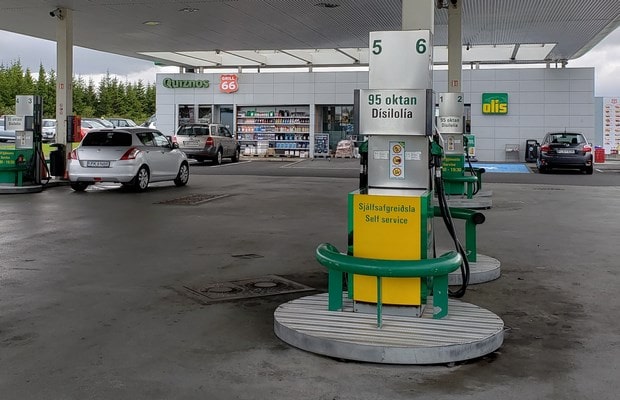

This method is cumbersome, and service shops are only available in cities. Smaller towns and remote areas have unattended stations only.
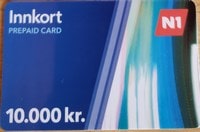

As mentioned earlier, N1 and Skeljungur offer prepaid fuel cards, allowing foreign tourists to refuel without worrying about credit card compatibility. N1 is more expensive but has widespread coverage, making it the top choice for most visitors. If budget is a concern, Skeljungur’s card is a viable alternative—just plan your refueling stops carefully.
During our trip, we bought three N1 prepaid cards, each worth 10,000 ISK (other denominations: 5,000 ISK and 2,000 ISK). These cards are sold at N1 service shops (attached to stations in major towns). Remote areas and smaller towns (e.g., Vík, Höfn) lack service shops. Unused card balances can be spent at N1 convenience stores.
Here’s a quick guide to using an N1 prepaid card:
- Step 1: Park next to a pump and turn off the engine.
- Step 2: Open the fuel cap.
- Step 3: Wear gloves (provided at stations for hygiene and possibly static protection).
- Step 4: Insert the N1 card into the pump’s card reader (N1 logo facing in).
- Step 5: Select your pump number on the screen.
- Step 6: Reinsert the card if prompted.
- Step 7: Remove the designated nozzle, insert it into the tank, and hold it firmly (you’ll hear/feel fuel flowing).
- Step 8: When the tank is full, the nozzle will click. Remove it carefully (residual fuel may drip). If the card balance is insufficient, the nozzle stops when funds run out.
- Step 9: Close the fuel cap.
- Step 10: Note the amount displayed on the pump (it won’t show the remaining balance, so track your spending).
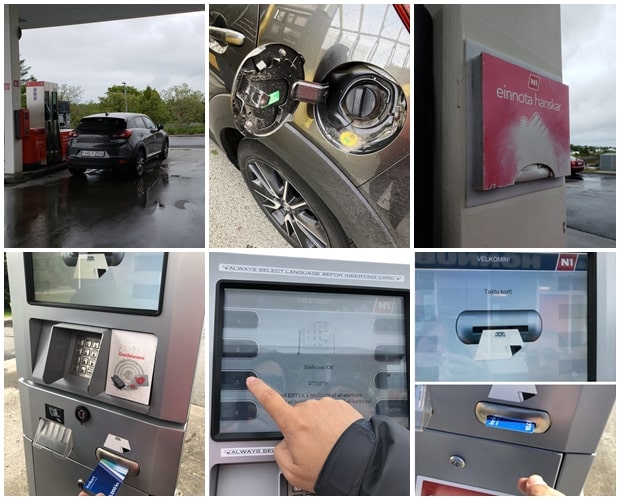

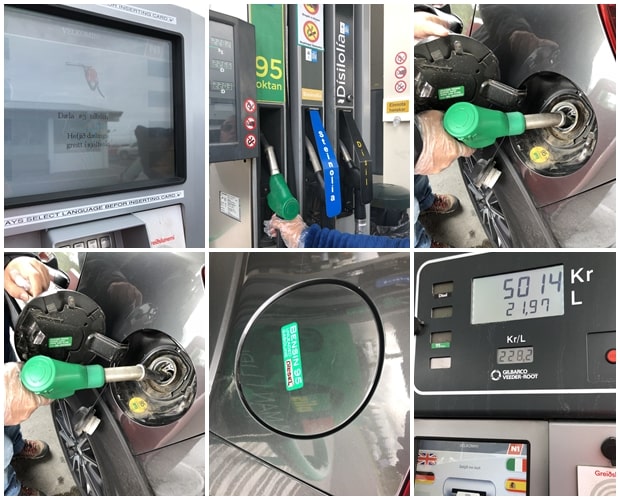

4. Car Washing
Driving in Iceland’s countryside, especially in rainy or windy conditions, quickly coats your car in dust. Some travelers keep it as a badge of honor, but I prefer a clean vehicle. Most Icelandic gas stations have car wash facilities with hoses and tools, so you can wash your car or clean the windshield if needed.
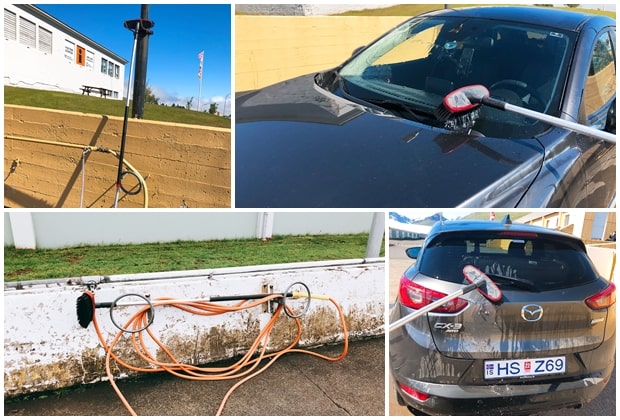

If your car is excessively dirty when returning it, some rental companies may charge a cleaning fee. To avoid this, wash the car before returning it.
10. Navigation
Car rental companies in Iceland usually charge extra for GPS navigation—typically 1,500–1,800 ISK per day, which isn’t cheap. Fortunately, Iceland’s roads are simple: outside cities, there are often just one or two routes. Even without a map, road signs are sufficient. With a smartphone map and GPS, you can easily navigate without renting a GPS device. Many free navigation apps are available, making paid rentals unnecessary.
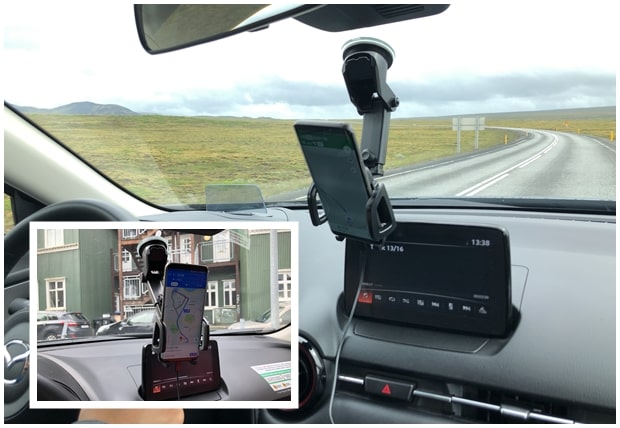

In our Australia Self-Drive Guide, we introduced four free navigation apps: Google Maps, Here WeGo, navmii, and maps.me. For Iceland, however, simpler apps like Google Maps are sufficient. It’s user-friendly, offers voice guidance in Mandarin and Cantonese, and is familiar to most travelers.
Google Maps allows offline map downloads (expiring after 28 days), so download Iceland’s map before your trip to save data. Also, bookmark your destinations in the app for quick access during navigation.
While offline maps reduce data usage, real-time navigation still requires internet. Thus, buy a European SIM card or rent a portable Wi-Fi device for your trip.
Additionally, prepare these tools for using navigation apps:
- A power bank: Navigation drains phone batteries; a backup reduces reliance on car charging.
- A car charger: For recharging when the power bank runs out.
- A charging cable: Essential for both power banks and car chargers.
- A phone mount: A must-have for hands-free navigation.
Related posts:
- Iceland Travel: 14-Day Iceland Ring Road Self-Drive Itinerary Design and Attraction Sharing + Iceland Travel Tips
- Australia Self-Drive Travel Guide: Detailed Introduction to Car Rental, Insurance, Parking, and Highway Tolls in Australia
- Agoda Promo Code – Flight & Hotel Coupon Code Collection
- Agoda Hotel Booking Guide: Cancellation, Date Changes, Payment Methods, Fees, Refunds, and Money-Saving Tips
- Agoda Flights! Reviews and Price Comparison


